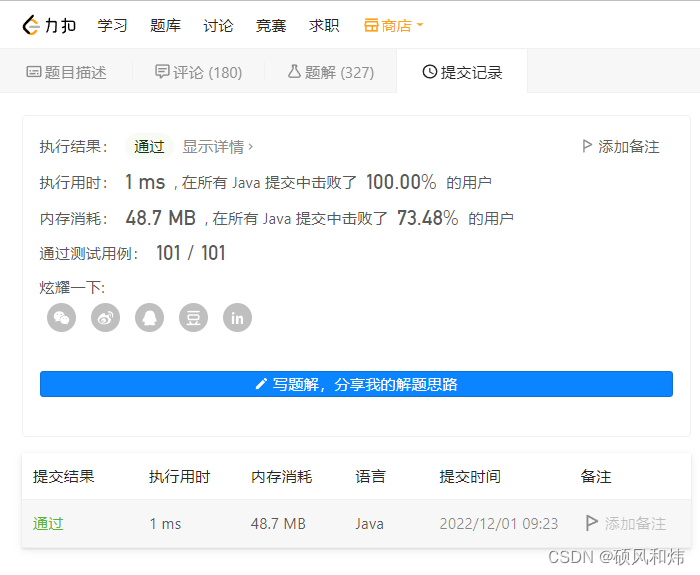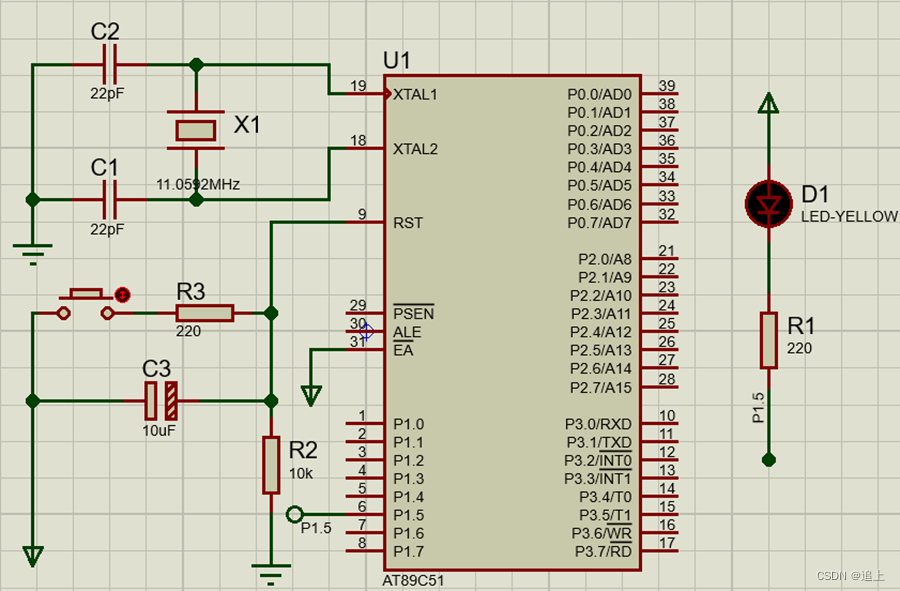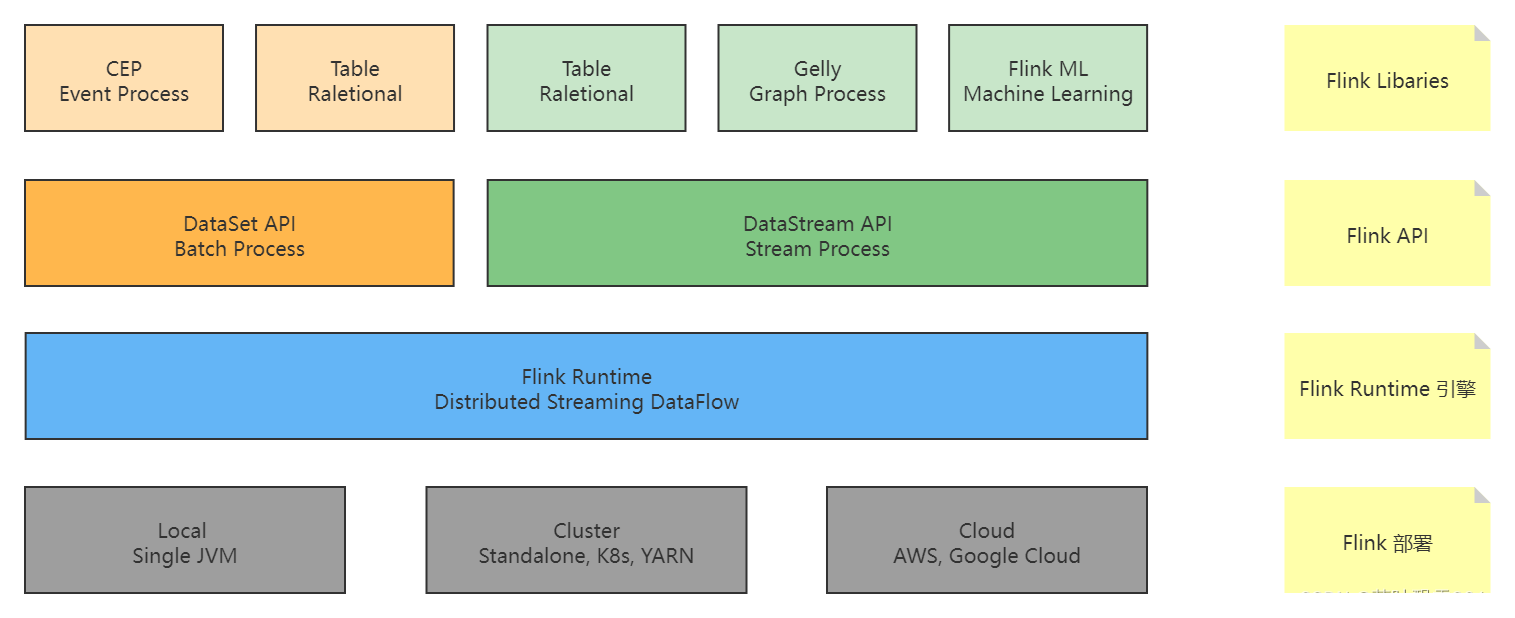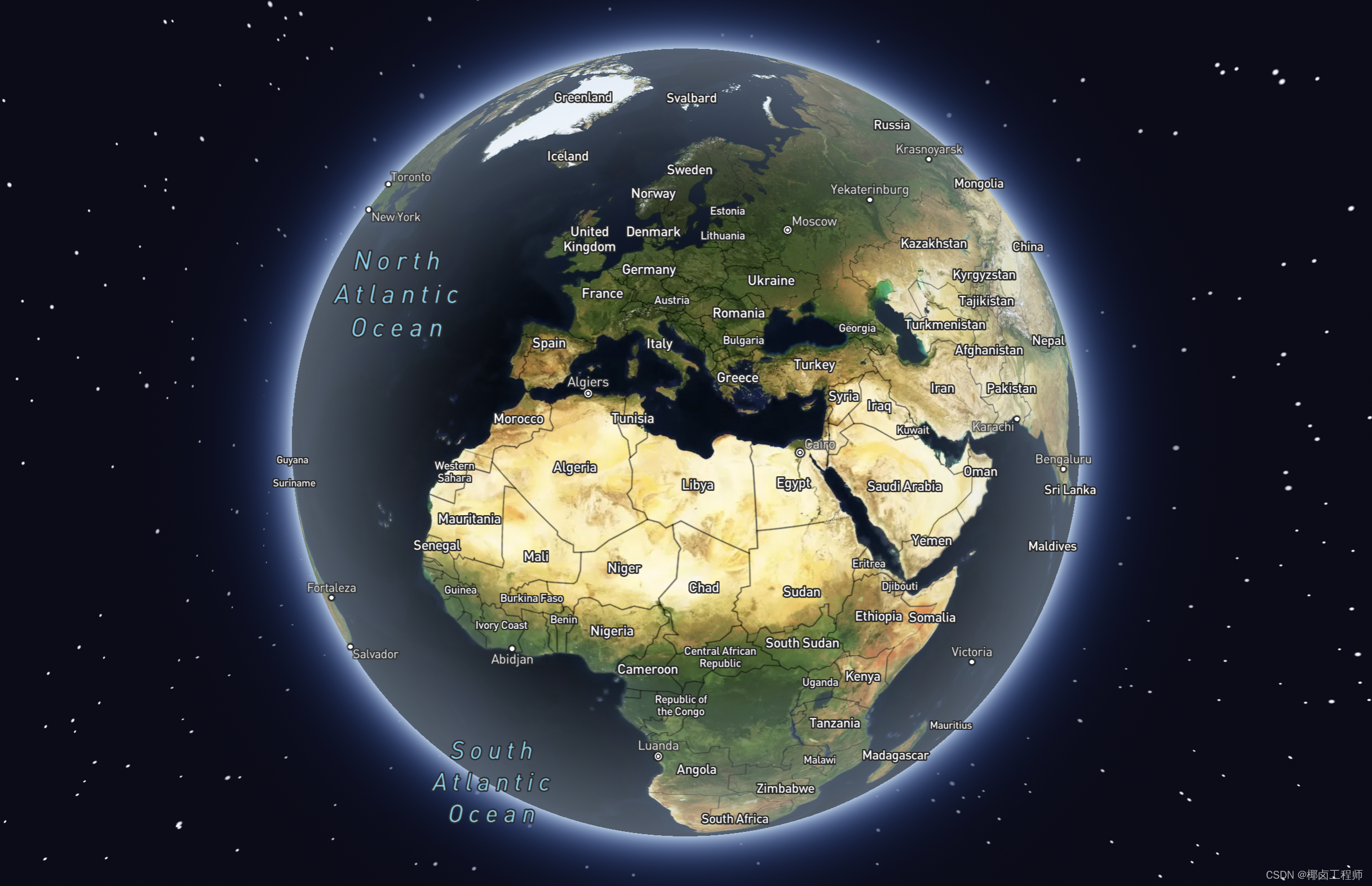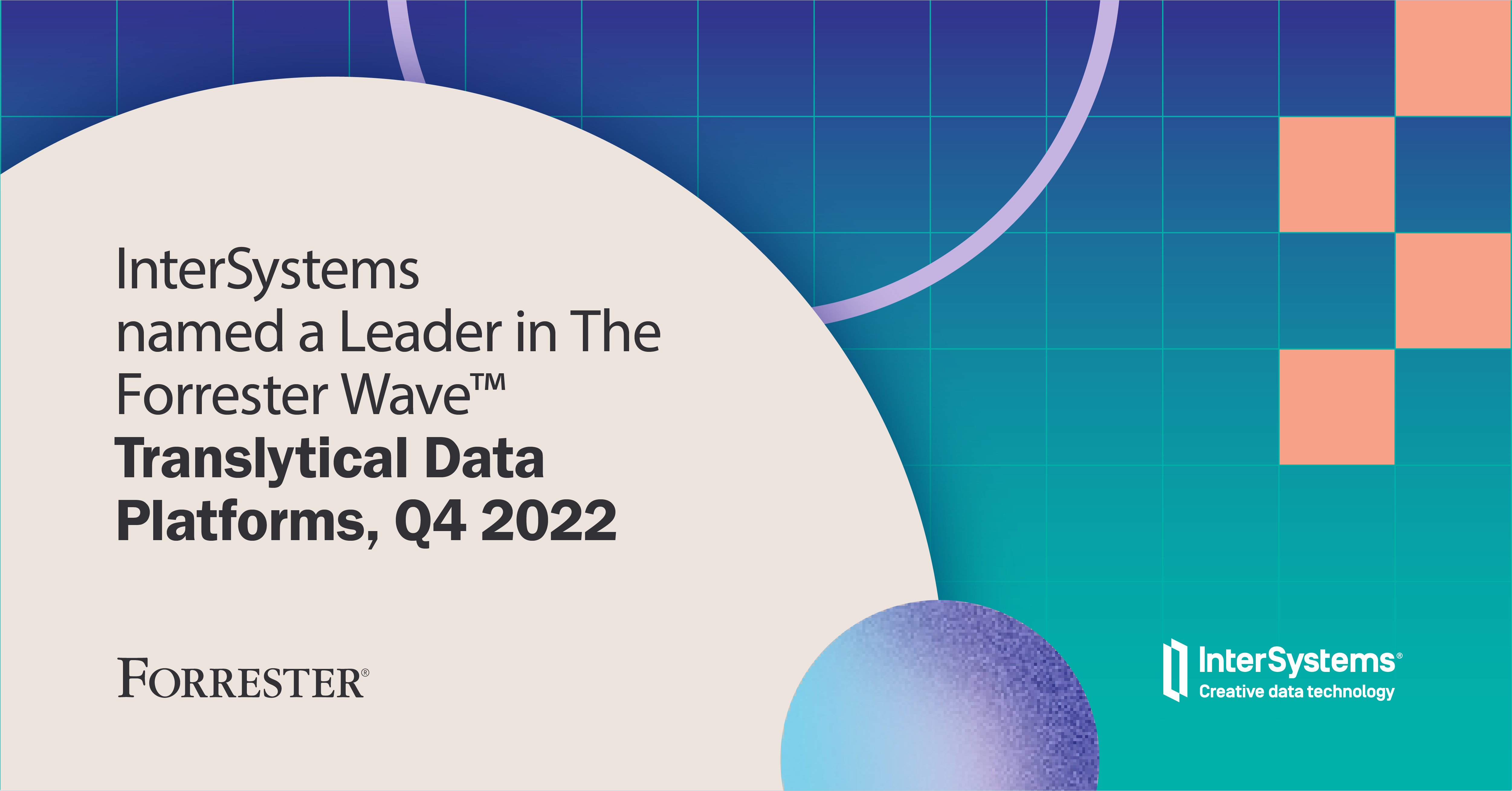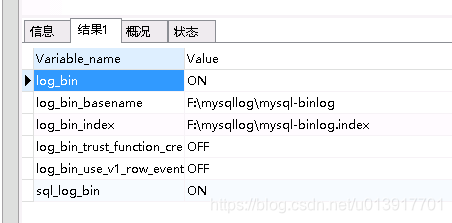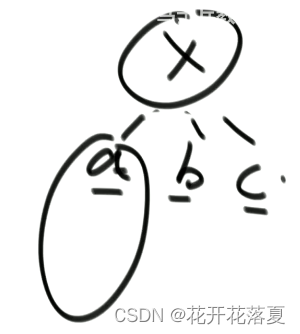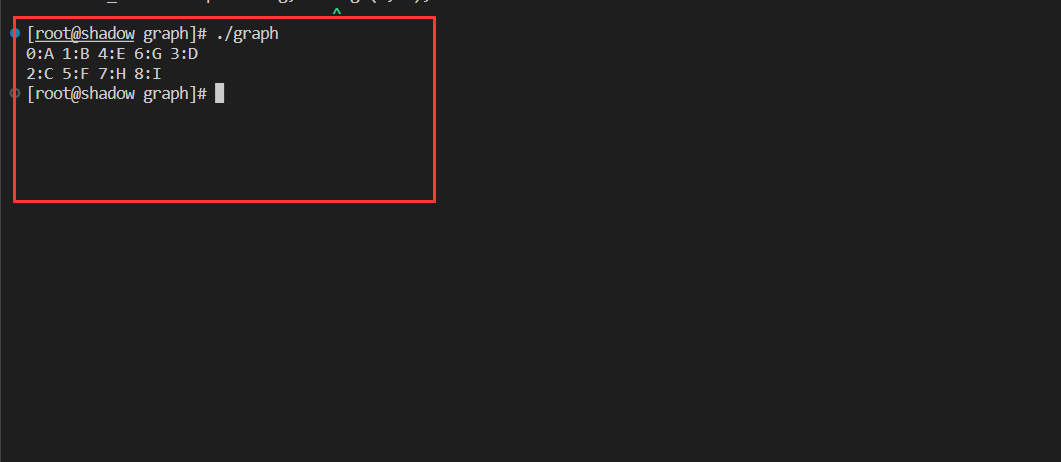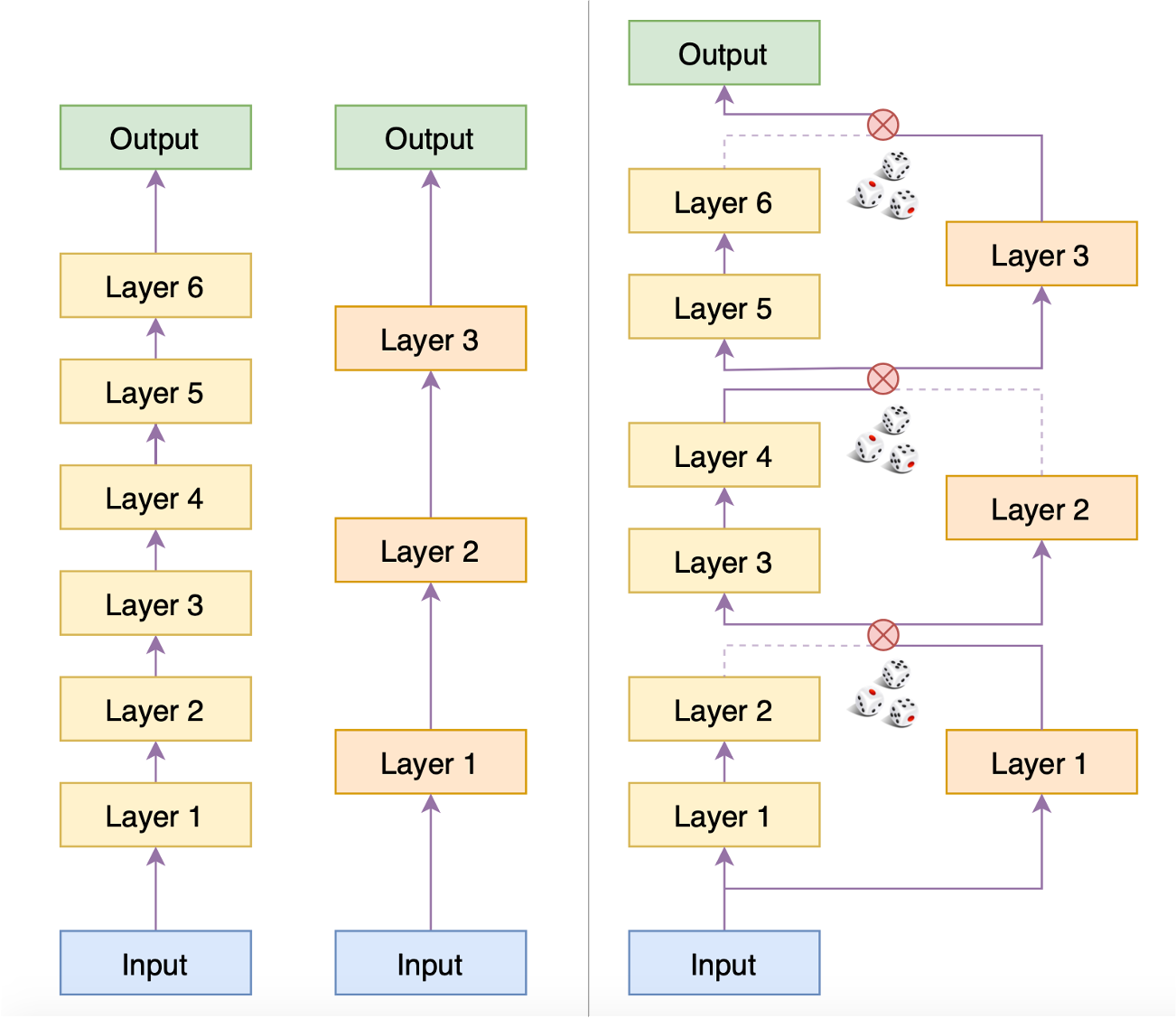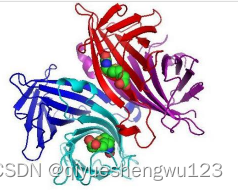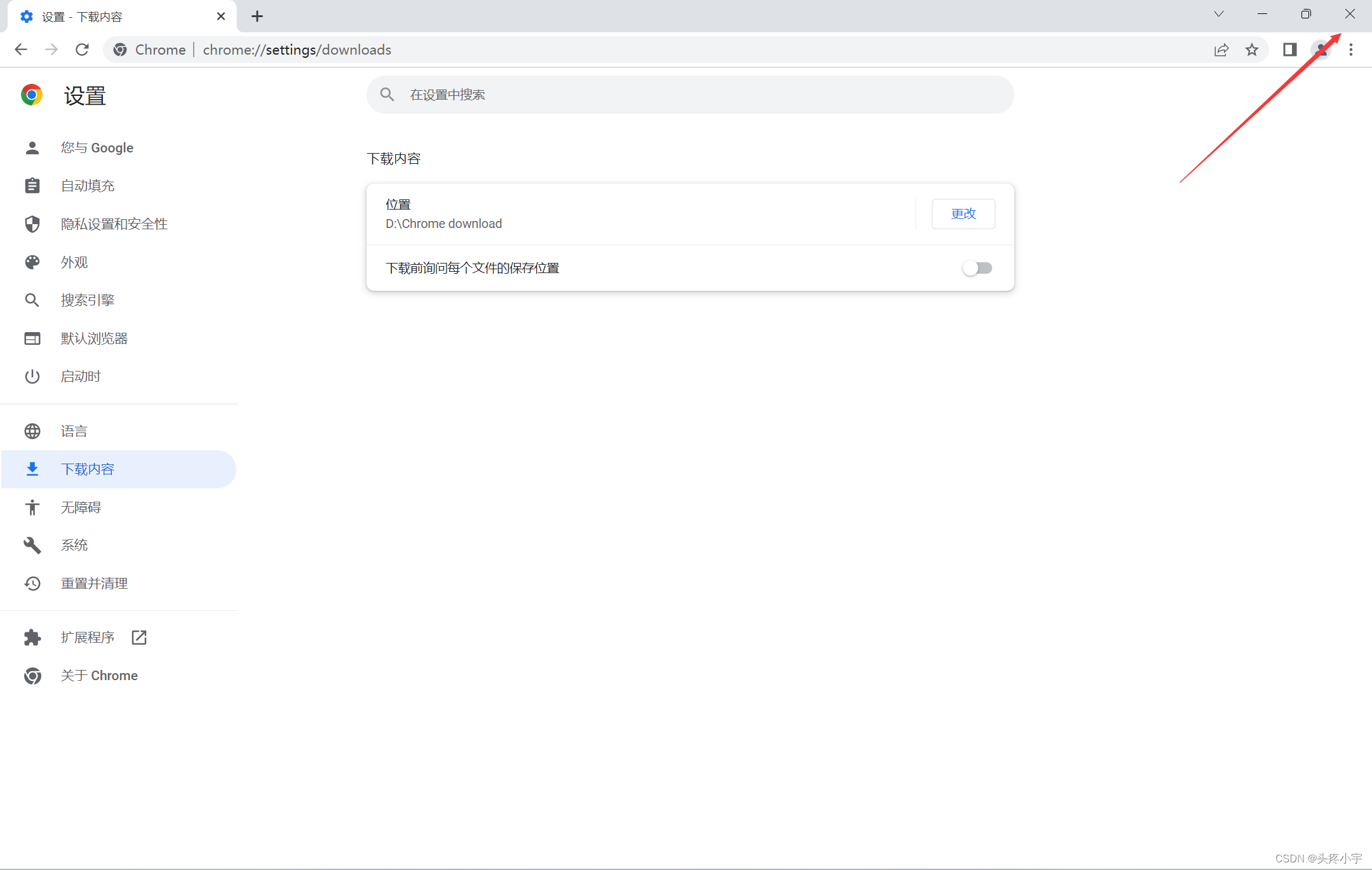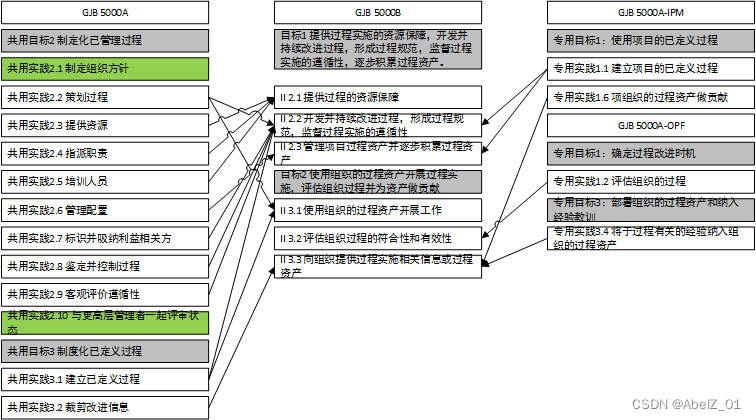Faster R-CNN 论文复现代码
详细的代码使用守则:
https://github.com/biluko/Faster-RCNN-Pytorch
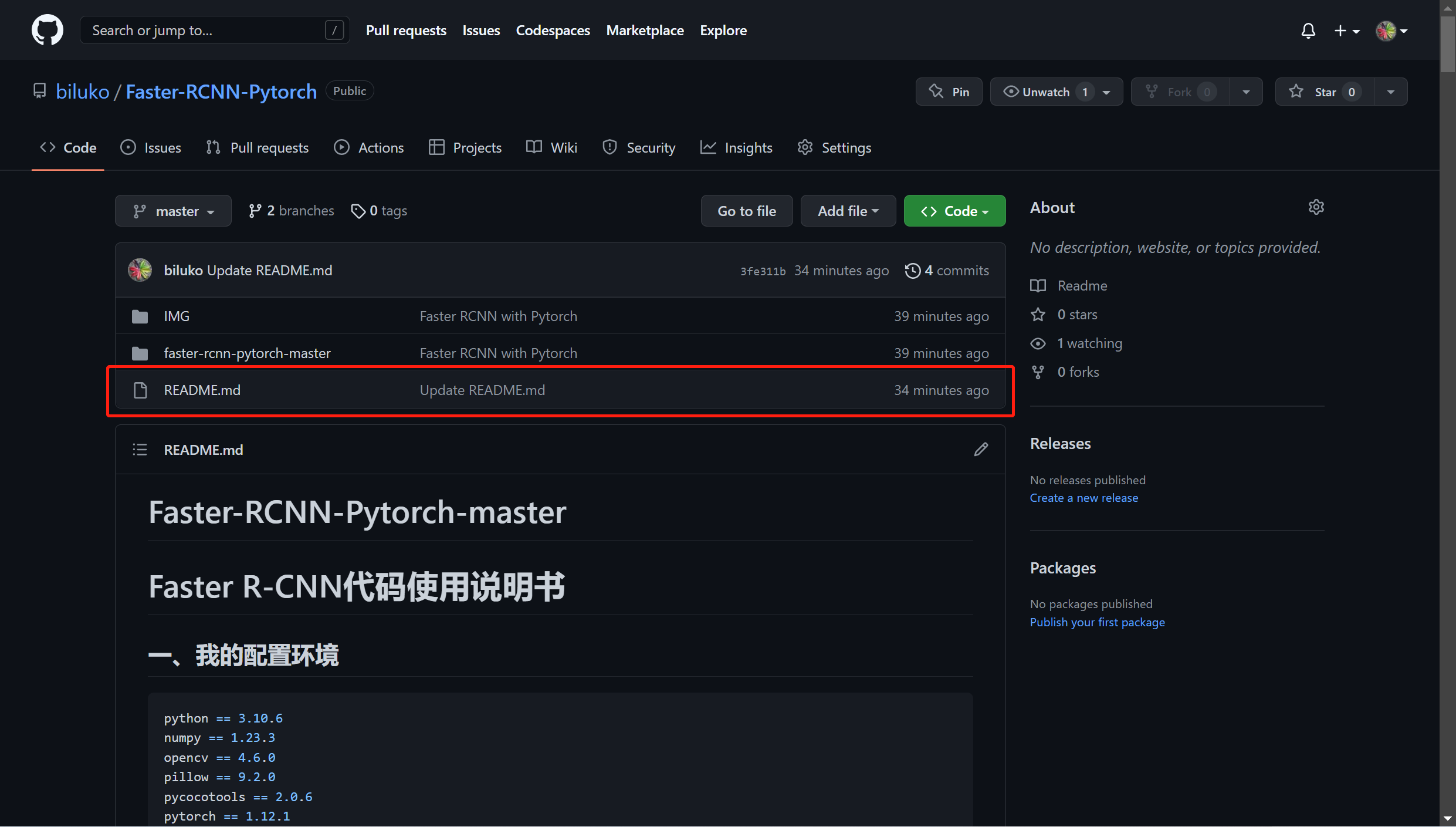
博客地址为:
https://blog.csdn.net/wzk4869/article/details/128133224?spm=1001.2014.3001.5501
一、nets文件夹下
init.py
classifier.py
import warningsimport torch
from torch import nn
from torchvision.ops import RoIPoolwarnings.filterwarnings("ignore")class VGG16RoIHead(nn.Module):def __init__(self, n_class, roi_size, spatial_scale, classifier):super(VGG16RoIHead, self).__init__()self.classifier = classifier#--------------------------------------## 对ROIPooling后的的结果进行回归预测#--------------------------------------#self.cls_loc = nn.Linear(4096, n_class * 4)#-----------------------------------## 对ROIPooling后的的结果进行分类#-----------------------------------#self.score = nn.Linear(4096, n_class)#-----------------------------------## 权值初始化#-----------------------------------#normal_init(self.cls_loc, 0, 0.001)normal_init(self.score, 0, 0.01)self.roi = RoIPool((roi_size, roi_size), spatial_scale)def forward(self, x, rois, roi_indices, img_size):n, _, _, _ = x.shapeif x.is_cuda:roi_indices = roi_indices.cuda()rois = rois.cuda()rois = torch.flatten(rois, 0, 1)roi_indices = torch.flatten(roi_indices, 0, 1)rois_feature_map = torch.zeros_like(rois)rois_feature_map[:, [0, 2]] = rois[:, [0, 2]] / img_size[1] * x.size()[3]rois_feature_map[:, [1, 3]] = rois[:, [1, 3]] / img_size[0] * x.size()[2]indices_and_rois = torch.cat([roi_indices[:, None], rois_feature_map], dim = 1)#-----------------------------------## 利用建议框对公用特征层进行截取#-----------------------------------#pool = self.roi(x, indices_and_rois)#-----------------------------------## 利用classifier网络进行特征提取#-----------------------------------#pool = pool.view(pool.size(0), -1)#--------------------------------------------------------------## 当输入为一张图片的时候,这里获得的f7的shape为[300, 4096]#--------------------------------------------------------------#fc7 = self.classifier(pool)roi_cls_locs = self.cls_loc(fc7)roi_scores = self.score(fc7)roi_cls_locs = roi_cls_locs.view(n, -1, roi_cls_locs.size(1))roi_scores = roi_scores.view(n, -1, roi_scores.size(1))return roi_cls_locs, roi_scoresclass Resnet50RoIHead(nn.Module):def __init__(self, n_class, roi_size, spatial_scale, classifier):super(Resnet50RoIHead, self).__init__()self.classifier = classifier#--------------------------------------## 对ROIPooling后的的结果进行回归预测#--------------------------------------#self.cls_loc = nn.Linear(2048, n_class * 4)#-----------------------------------## 对ROIPooling后的的结果进行分类#-----------------------------------#self.score = nn.Linear(2048, n_class)#-----------------------------------## 权值初始化#-----------------------------------#normal_init(self.cls_loc, 0, 0.001)normal_init(self.score, 0, 0.01)self.roi = RoIPool((roi_size, roi_size), spatial_scale)def forward(self, x, rois, roi_indices, img_size):n, _, _, _ = x.shapeif x.is_cuda:roi_indices = roi_indices.cuda()rois = rois.cuda()rois = torch.flatten(rois, 0, 1)roi_indices = torch.flatten(roi_indices, 0, 1)rois_feature_map = torch.zeros_like(rois)rois_feature_map[:, [0, 2]] = rois[:, [0, 2]] / img_size[1] * x.size()[3]rois_feature_map[:, [1, 3]] = rois[:, [1, 3]] / img_size[0] * x.size()[2]indices_and_rois = torch.cat([roi_indices[:, None], rois_feature_map], dim = 1)#-----------------------------------## 利用建议框对公用特征层进行截取#-----------------------------------#pool = self.roi(x, indices_and_rois)#-----------------------------------## 利用classifier网络进行特征提取#-----------------------------------#fc7 = self.classifier(pool)#--------------------------------------------------------------## 当输入为一张图片的时候,这里获得的f7的shape为[300, 2048]#--------------------------------------------------------------#fc7 = fc7.view(fc7.size(0), -1)roi_cls_locs = self.cls_loc(fc7)roi_scores = self.score(fc7)roi_cls_locs = roi_cls_locs.view(n, -1, roi_cls_locs.size(1))roi_scores = roi_scores.view(n, -1, roi_scores.size(1))return roi_cls_locs, roi_scoresdef normal_init(m, mean, stddev, truncated = False):if truncated:m.weight.data.normal_().fmod_(2).mul_(stddev).add_(mean) # not a perfect approximationelse:m.weight.data.normal_(mean, stddev)m.bias.data.zero_()
rcnn_training.py
import math
from functools import partialimport numpy as np
import torch
import torch.nn as nn
from torch.nn import functional as Fdef bbox_iou(bbox_a, bbox_b):if bbox_a.shape[1] != 4 or bbox_b.shape[1] != 4:print(bbox_a, bbox_b)raise IndexErrortl = np.maximum(bbox_a[:, None, :2], bbox_b[:, :2])br = np.minimum(bbox_a[:, None, 2:], bbox_b[:, 2:])area_i = np.prod(br - tl, axis=2) * (tl < br).all(axis=2)area_a = np.prod(bbox_a[:, 2:] - bbox_a[:, :2], axis=1)area_b = np.prod(bbox_b[:, 2:] - bbox_b[:, :2], axis=1)return area_i / (area_a[:, None] + area_b - area_i)def bbox2loc(src_bbox, dst_bbox):width = src_bbox[:, 2] - src_bbox[:, 0]height = src_bbox[:, 3] - src_bbox[:, 1]ctr_x = src_bbox[:, 0] + 0.5 * widthctr_y = src_bbox[:, 1] + 0.5 * heightbase_width = dst_bbox[:, 2] - dst_bbox[:, 0]base_height = dst_bbox[:, 3] - dst_bbox[:, 1]base_ctr_x = dst_bbox[:, 0] + 0.5 * base_widthbase_ctr_y = dst_bbox[:, 1] + 0.5 * base_heighteps = np.finfo(height.dtype).epswidth = np.maximum(width, eps)height = np.maximum(height, eps)dx = (base_ctr_x - ctr_x) / widthdy = (base_ctr_y - ctr_y) / heightdw = np.log(base_width / width)dh = np.log(base_height / height)loc = np.vstack((dx, dy, dw, dh)).transpose()return locclass AnchorTargetCreator(object):def __init__(self, n_sample=256, pos_iou_thresh=0.7, neg_iou_thresh=0.3, pos_ratio=0.5):self.n_sample = n_sampleself.pos_iou_thresh = pos_iou_threshself.neg_iou_thresh = neg_iou_threshself.pos_ratio = pos_ratiodef __call__(self, bbox, anchor):argmax_ious, label = self._create_label(anchor, bbox)if (label > 0).any():loc = bbox2loc(anchor, bbox[argmax_ious])return loc, labelelse:return np.zeros_like(anchor), labeldef _calc_ious(self, anchor, bbox):#----------------------------------------------## anchor和bbox的iou# 获得的ious的shape为[num_anchors, num_gt]#----------------------------------------------#ious = bbox_iou(anchor, bbox)if len(bbox)==0:return np.zeros(len(anchor), np.int32), np.zeros(len(anchor)), np.zeros(len(bbox))#---------------------------------------------------------## 获得每一个先验框最对应的真实框 [num_anchors, ]#---------------------------------------------------------#argmax_ious = ious.argmax(axis=1)#---------------------------------------------------------## 找出每一个先验框最对应的真实框的iou [num_anchors, ]#---------------------------------------------------------#max_ious = np.max(ious, axis=1)#---------------------------------------------------------## 获得每一个真实框最对应的先验框 [num_gt, ]#---------------------------------------------------------#gt_argmax_ious = ious.argmax(axis=0)#---------------------------------------------------------## 保证每一个真实框都存在对应的先验框#---------------------------------------------------------#for i in range(len(gt_argmax_ious)):argmax_ious[gt_argmax_ious[i]] = ireturn argmax_ious, max_ious, gt_argmax_iousdef _create_label(self, anchor, bbox):# ------------------------------------------ ## 1是正样本,0是负样本,-1忽略# 初始化的时候全部设置为-1# ------------------------------------------ #label = np.empty((len(anchor),), dtype=np.int32)label.fill(-1)# ------------------------------------------------------------------------ ## argmax_ious为每个先验框对应的最大的真实框的序号 [num_anchors, ]# max_ious为每个真实框对应的最大的真实框的iou [num_anchors, ]# gt_argmax_ious为每一个真实框对应的最大的先验框的序号 [num_gt, ]# ------------------------------------------------------------------------ #argmax_ious, max_ious, gt_argmax_ious = self._calc_ious(anchor, bbox)# ----------------------------------------------------- ## 如果小于门限值则设置为负样本# 如果大于门限值则设置为正样本# 每个真实框至少对应一个先验框# ----------------------------------------------------- #label[max_ious < self.neg_iou_thresh] = 0label[max_ious >= self.pos_iou_thresh] = 1if len(gt_argmax_ious)>0:label[gt_argmax_ious] = 1# ----------------------------------------------------- ## 判断正样本数量是否大于128,如果大于则限制在128# ----------------------------------------------------- #n_pos = int(self.pos_ratio * self.n_sample)pos_index = np.where(label == 1)[0]if len(pos_index) > n_pos:disable_index = np.random.choice(pos_index, size=(len(pos_index) - n_pos), replace=False)label[disable_index] = -1# ----------------------------------------------------- ## 平衡正负样本,保持总数量为256# ----------------------------------------------------- #n_neg = self.n_sample - np.sum(label == 1)neg_index = np.where(label == 0)[0]if len(neg_index) > n_neg:disable_index = np.random.choice(neg_index, size=(len(neg_index) - n_neg), replace=False)label[disable_index] = -1return argmax_ious, labelclass ProposalTargetCreator(object):def __init__(self, n_sample=128, pos_ratio=0.5, pos_iou_thresh=0.5, neg_iou_thresh_high=0.5, neg_iou_thresh_low=0):self.n_sample = n_sampleself.pos_ratio = pos_ratioself.pos_roi_per_image = np.round(self.n_sample * self.pos_ratio)self.pos_iou_thresh = pos_iou_threshself.neg_iou_thresh_high = neg_iou_thresh_highself.neg_iou_thresh_low = neg_iou_thresh_lowdef __call__(self, roi, bbox, label, loc_normalize_std=(0.1, 0.1, 0.2, 0.2)):roi = np.concatenate((roi.detach().cpu().numpy(), bbox), axis=0)# ----------------------------------------------------- ## 计算建议框和真实框的重合程度# ----------------------------------------------------- #iou = bbox_iou(roi, bbox)if len(bbox)==0:gt_assignment = np.zeros(len(roi), np.int32)max_iou = np.zeros(len(roi))gt_roi_label = np.zeros(len(roi))else:#---------------------------------------------------------## 获得每一个建议框最对应的真实框 [num_roi, ]#---------------------------------------------------------#gt_assignment = iou.argmax(axis=1)#---------------------------------------------------------## 获得每一个建议框最对应的真实框的iou [num_roi, ]#---------------------------------------------------------#max_iou = iou.max(axis=1)#---------------------------------------------------------## 真实框的标签要+1因为有背景的存在#---------------------------------------------------------#gt_roi_label = label[gt_assignment] + 1#----------------------------------------------------------------## 满足建议框和真实框重合程度大于neg_iou_thresh_high的作为负样本# 将正样本的数量限制在self.pos_roi_per_image以内#----------------------------------------------------------------#pos_index = np.where(max_iou >= self.pos_iou_thresh)[0]pos_roi_per_this_image = int(min(self.pos_roi_per_image, pos_index.size))if pos_index.size > 0:pos_index = np.random.choice(pos_index, size=pos_roi_per_this_image, replace=False)#-----------------------------------------------------------------------------------------------------## 满足建议框和真实框重合程度小于neg_iou_thresh_high大于neg_iou_thresh_low作为负样本# 将正样本的数量和负样本的数量的总和固定成self.n_sample#-----------------------------------------------------------------------------------------------------#neg_index = np.where((max_iou < self.neg_iou_thresh_high) & (max_iou >= self.neg_iou_thresh_low))[0]neg_roi_per_this_image = self.n_sample - pos_roi_per_this_imageneg_roi_per_this_image = int(min(neg_roi_per_this_image, neg_index.size))if neg_index.size > 0:neg_index = np.random.choice(neg_index, size=neg_roi_per_this_image, replace=False)#---------------------------------------------------------## sample_roi [n_sample, ]# gt_roi_loc [n_sample, 4]# gt_roi_label [n_sample, ]#---------------------------------------------------------#keep_index = np.append(pos_index, neg_index)sample_roi = roi[keep_index]if len(bbox)==0:return sample_roi, np.zeros_like(sample_roi), gt_roi_label[keep_index]gt_roi_loc = bbox2loc(sample_roi, bbox[gt_assignment[keep_index]])gt_roi_loc = (gt_roi_loc / np.array(loc_normalize_std, np.float32))gt_roi_label = gt_roi_label[keep_index]gt_roi_label[pos_roi_per_this_image:] = 0return sample_roi, gt_roi_loc, gt_roi_labelclass FasterRCNNTrainer(nn.Module):def __init__(self, model_train, optimizer):super(FasterRCNNTrainer, self).__init__()self.model_train = model_trainself.optimizer = optimizerself.rpn_sigma = 1self.roi_sigma = 1self.anchor_target_creator = AnchorTargetCreator()self.proposal_target_creator = ProposalTargetCreator()self.loc_normalize_std = [0.1, 0.1, 0.2, 0.2]def _fast_rcnn_loc_loss(self, pred_loc, gt_loc, gt_label, sigma):pred_loc = pred_loc[gt_label > 0]gt_loc = gt_loc[gt_label > 0]sigma_squared = sigma ** 2regression_diff = (gt_loc - pred_loc)regression_diff = regression_diff.abs().float()regression_loss = torch.where(regression_diff < (1. / sigma_squared),0.5 * sigma_squared * regression_diff ** 2,regression_diff - 0.5 / sigma_squared)regression_loss = regression_loss.sum()num_pos = (gt_label > 0).sum().float()regression_loss /= torch.max(num_pos, torch.ones_like(num_pos))return regression_lossdef forward(self, imgs, bboxes, labels, scale):n = imgs.shape[0]img_size = imgs.shape[2:]#-------------------------------## 获取公用特征层#-------------------------------#base_feature = self.model_train(imgs, mode = 'extractor')# -------------------------------------------------- ## 利用rpn网络获得调整参数、得分、建议框、先验框# -------------------------------------------------- #rpn_locs, rpn_scores, rois, roi_indices, anchor = self.model_train(x = [base_feature, img_size], scale = scale, mode = 'rpn')rpn_loc_loss_all, rpn_cls_loss_all, roi_loc_loss_all, roi_cls_loss_all = 0, 0, 0, 0sample_rois, sample_indexes, gt_roi_locs, gt_roi_labels = [], [], [], []for i in range(n):bbox = bboxes[i]label = labels[i]rpn_loc = rpn_locs[i]rpn_score = rpn_scores[i]roi = rois[i]# -------------------------------------------------- ## 利用真实框和先验框获得建议框网络应该有的预测结果# 给每个先验框都打上标签# gt_rpn_loc [num_anchors, 4]# gt_rpn_label [num_anchors, ]# -------------------------------------------------- #gt_rpn_loc, gt_rpn_label = self.anchor_target_creator(bbox, anchor[0].cpu().numpy())gt_rpn_loc = torch.Tensor(gt_rpn_loc).type_as(rpn_locs)gt_rpn_label = torch.Tensor(gt_rpn_label).type_as(rpn_locs).long()# -------------------------------------------------- ## 分别计算建议框网络的回归损失和分类损失# -------------------------------------------------- #rpn_loc_loss = self._fast_rcnn_loc_loss(rpn_loc, gt_rpn_loc, gt_rpn_label, self.rpn_sigma)rpn_cls_loss = F.cross_entropy(rpn_score, gt_rpn_label, ignore_index=-1)rpn_loc_loss_all += rpn_loc_lossrpn_cls_loss_all += rpn_cls_loss# ------------------------------------------------------ ## 利用真实框和建议框获得classifier网络应该有的预测结果# 获得三个变量,分别是sample_roi, gt_roi_loc, gt_roi_label# sample_roi [n_sample, ]# gt_roi_loc [n_sample, 4]# gt_roi_label [n_sample, ]# ------------------------------------------------------ #sample_roi, gt_roi_loc, gt_roi_label = self.proposal_target_creator(roi, bbox, label, self.loc_normalize_std)sample_rois.append(torch.Tensor(sample_roi).type_as(rpn_locs))sample_indexes.append(torch.ones(len(sample_roi)).type_as(rpn_locs) * roi_indices[i][0])gt_roi_locs.append(torch.Tensor(gt_roi_loc).type_as(rpn_locs))gt_roi_labels.append(torch.Tensor(gt_roi_label).type_as(rpn_locs).long())sample_rois = torch.stack(sample_rois, dim=0)sample_indexes = torch.stack(sample_indexes, dim=0)roi_cls_locs, roi_scores = self.model_train([base_feature, sample_rois, sample_indexes, img_size], mode = 'head')for i in range(n):# ------------------------------------------------------ ## 根据建议框的种类,取出对应的回归预测结果# ------------------------------------------------------ #n_sample = roi_cls_locs.size()[1]roi_cls_loc = roi_cls_locs[i]roi_score = roi_scores[i]gt_roi_loc = gt_roi_locs[i]gt_roi_label = gt_roi_labels[i]roi_cls_loc = roi_cls_loc.view(n_sample, -1, 4)roi_loc = roi_cls_loc[torch.arange(0, n_sample), gt_roi_label]# -------------------------------------------------- ## 分别计算Classifier网络的回归损失和分类损失# -------------------------------------------------- #roi_loc_loss = self._fast_rcnn_loc_loss(roi_loc, gt_roi_loc, gt_roi_label.data, self.roi_sigma)roi_cls_loss = nn.CrossEntropyLoss()(roi_score, gt_roi_label)roi_loc_loss_all += roi_loc_lossroi_cls_loss_all += roi_cls_losslosses = [rpn_loc_loss_all/n, rpn_cls_loss_all/n, roi_loc_loss_all/n, roi_cls_loss_all/n]losses = losses + [sum(losses)]return lossesdef train_step(self, imgs, bboxes, labels, scale, fp16=False, scaler=None):self.optimizer.zero_grad()if not fp16:losses = self.forward(imgs, bboxes, labels, scale)losses[-1].backward()self.optimizer.step()else:from torch.cuda.amp import autocastwith autocast():losses = self.forward(imgs, bboxes, labels, scale)#----------------------## 反向传播#----------------------#scaler.scale(losses[-1]).backward()scaler.step(self.optimizer)scaler.update()return lossesdef weights_init(net, init_type='normal', init_gain=0.02):def init_func(m):classname = m.__class__.__name__if hasattr(m, 'weight') and classname.find('Conv') != -1:if init_type == 'normal':torch.nn.init.normal_(m.weight.data, 0.0, init_gain)elif init_type == 'xavier':torch.nn.init.xavier_normal_(m.weight.data, gain=init_gain)elif init_type == 'kaiming':torch.nn.init.kaiming_normal_(m.weight.data, a=0, mode='fan_in')elif init_type == 'orthogonal':torch.nn.init.orthogonal_(m.weight.data, gain=init_gain)else:raise NotImplementedError('initialization method [%s] is not implemented' % init_type)elif classname.find('BatchNorm2d') != -1:torch.nn.init.normal_(m.weight.data, 1.0, 0.02)torch.nn.init.constant_(m.bias.data, 0.0)print('initialize network with %s type' % init_type)net.apply(init_func)def get_lr_scheduler(lr_decay_type, lr, min_lr, total_iters, warmup_iters_ratio = 0.05, warmup_lr_ratio = 0.1, no_aug_iter_ratio = 0.05, step_num = 10):def yolox_warm_cos_lr(lr, min_lr, total_iters, warmup_total_iters, warmup_lr_start, no_aug_iter, iters):if iters <= warmup_total_iters:# lr = (lr - warmup_lr_start) * iters / float(warmup_total_iters) + warmup_lr_startlr = (lr - warmup_lr_start) * pow(iters / float(warmup_total_iters), 2) + warmup_lr_startelif iters >= total_iters - no_aug_iter:lr = min_lrelse:lr = min_lr + 0.5 * (lr - min_lr) * (1.0 + math.cos(math.pi* (iters - warmup_total_iters) / (total_iters - warmup_total_iters - no_aug_iter)))return lrdef step_lr(lr, decay_rate, step_size, iters):if step_size < 1:raise ValueError("step_size must above 1.")n = iters // step_sizeout_lr = lr * decay_rate ** nreturn out_lrif lr_decay_type == "cos":warmup_total_iters = min(max(warmup_iters_ratio * total_iters, 1), 3)warmup_lr_start = max(warmup_lr_ratio * lr, 1e-6)no_aug_iter = min(max(no_aug_iter_ratio * total_iters, 1), 15)func = partial(yolox_warm_cos_lr ,lr, min_lr, total_iters, warmup_total_iters, warmup_lr_start, no_aug_iter)else:decay_rate = (min_lr / lr) ** (1 / (step_num - 1))step_size = total_iters / step_numfunc = partial(step_lr, lr, decay_rate, step_size)return funcdef set_optimizer_lr(optimizer, lr_scheduler_func, epoch):lr = lr_scheduler_func(epoch)for param_group in optimizer.param_groups:param_group['lr'] = lrfrcnn.py
import torch.nn as nn
from nets.classifier import Resnet50RoIHead, VGG16RoIHead
from nets.resnet50 import resnet50
from nets.rpn import RegionProposalNetwork
from nets.vgg16 import decom_vgg16class FasterRCNN(nn.Module):def __init__(self, num_classes, mode = "training",feat_stride = 16,anchor_scales = [8, 16, 32],ratios = [0.5, 1, 2],backbone = 'vgg',pretrained = False):super(FasterRCNN, self).__init__()self.feat_stride = feat_stride#---------------------------------## 一共存在两个主干# vgg和resnet50#---------------------------------#if backbone == 'vgg':self.extractor, classifier = decom_vgg16(pretrained)#---------------------------------## 构建建议框网络#---------------------------------#self.rpn = RegionProposalNetwork(512, 512,ratios = ratios,anchor_scales = anchor_scales,feat_stride = self.feat_stride,mode = mode)#---------------------------------## 构建分类器网络#---------------------------------#self.head = VGG16RoIHead(n_class = num_classes + 1,roi_size = 7,spatial_scale = 1,classifier = classifier)elif backbone == 'resnet50':self.extractor, classifier = resnet50(pretrained)#---------------------------------## 构建classifier网络#---------------------------------#self.rpn = RegionProposalNetwork(1024, 512,ratios = ratios,anchor_scales = anchor_scales,feat_stride = self.feat_stride,mode = mode)#---------------------------------## 构建classifier网络#---------------------------------#self.head = Resnet50RoIHead(n_class = num_classes + 1,roi_size = 14,spatial_scale = 1,classifier = classifier)def forward(self, x, scale=1., mode="forward"):if mode == "forward":#---------------------------------## 计算输入图片的大小#---------------------------------#img_size = x.shape[2:]#---------------------------------## 利用主干网络提取特征#---------------------------------#base_feature = self.extractor.forward(x)#---------------------------------## 获得建议框#---------------------------------#_, _, rois, roi_indices, _ = self.rpn.forward(base_feature, img_size, scale)#---------------------------------------## 获得classifier的分类结果和回归结果#---------------------------------------#roi_cls_locs, roi_scores = self.head.forward(base_feature, rois, roi_indices, img_size)return roi_cls_locs, roi_scores, rois, roi_indiceselif mode == "extractor":#---------------------------------## 利用主干网络提取特征#---------------------------------#base_feature = self.extractor.forward(x)return base_featureelif mode == "rpn":base_feature, img_size = x#---------------------------------## 获得建议框#---------------------------------#rpn_locs, rpn_scores, rois, roi_indices, anchor = self.rpn.forward(base_feature, img_size, scale)return rpn_locs, rpn_scores, rois, roi_indices, anchorelif mode == "head":base_feature, rois, roi_indices, img_size = x#---------------------------------------## 获得classifier的分类结果和回归结果#---------------------------------------#roi_cls_locs, roi_scores = self.head.forward(base_feature, rois, roi_indices, img_size)return roi_cls_locs, roi_scoresdef freeze_bn(self):for m in self.modules():if isinstance(m, nn.BatchNorm2d):m.eval()resnet50.py
import mathimport torch.nn as nn
from torch.hub import load_state_dict_from_urlclass Bottleneck(nn.Module):expansion = 4def __init__(self, inplanes, planes, stride=1, downsample=None):super(Bottleneck, self).__init__()self.conv1 = nn.Conv2d(inplanes, planes, kernel_size=1, stride=stride, bias=False)self.bn1 = nn.BatchNorm2d(planes)self.conv2 = nn.Conv2d(planes, planes, kernel_size=3, stride=1, padding=1, bias=False)self.bn2 = nn.BatchNorm2d(planes)self.conv3 = nn.Conv2d(planes, planes * 4, kernel_size=1, bias=False)self.bn3 = nn.BatchNorm2d(planes * 4)self.relu = nn.ReLU(inplace=True)self.downsample = downsampleself.stride = stridedef forward(self, x):residual = xout = self.conv1(x)out = self.bn1(out)out = self.relu(out)out = self.conv2(out)out = self.bn2(out)out = self.relu(out)out = self.conv3(out)out = self.bn3(out)if self.downsample is not None:residual = self.downsample(x)out += residualout = self.relu(out)return outclass ResNet(nn.Module):def __init__(self, block, layers, num_classes=1000):#-----------------------------------## 假设输入进来的图片是600,600,3#-----------------------------------#self.inplanes = 64super(ResNet, self).__init__()# 600,600,3 -> 300,300,64self.conv1 = nn.Conv2d(3, 64, kernel_size=7, stride=2, padding=3, bias=False)self.bn1 = nn.BatchNorm2d(64)self.relu = nn.ReLU(inplace=True)# 300,300,64 -> 150,150,64self.maxpool = nn.MaxPool2d(kernel_size=3, stride=2, padding=0, ceil_mode=True)# 150,150,64 -> 150,150,256self.layer1 = self._make_layer(block, 64, layers[0])# 150,150,256 -> 75,75,512self.layer2 = self._make_layer(block, 128, layers[1], stride=2)# 75,75,512 -> 38,38,1024 到这里可以获得一个38,38,1024的共享特征层self.layer3 = self._make_layer(block, 256, layers[2], stride=2)# self.layer4被用在classifier模型中self.layer4 = self._make_layer(block, 512, layers[3], stride=2)self.avgpool = nn.AvgPool2d(7)self.fc = nn.Linear(512 * block.expansion, num_classes)for m in self.modules():if isinstance(m, nn.Conv2d):n = m.kernel_size[0] * m.kernel_size[1] * m.out_channelsm.weight.data.normal_(0, math.sqrt(2. / n))elif isinstance(m, nn.BatchNorm2d):m.weight.data.fill_(1)m.bias.data.zero_()def _make_layer(self, block, planes, blocks, stride=1):downsample = None#-------------------------------------------------------------------## 当模型需要进行高和宽的压缩的时候,就需要用到残差边的downsample#-------------------------------------------------------------------#if stride != 1 or self.inplanes != planes * block.expansion:downsample = nn.Sequential(nn.Conv2d(self.inplanes, planes * block.expansion,kernel_size=1, stride=stride, bias=False),nn.BatchNorm2d(planes * block.expansion),)layers = []layers.append(block(self.inplanes, planes, stride, downsample))self.inplanes = planes * block.expansionfor i in range(1, blocks):layers.append(block(self.inplanes, planes))return nn.Sequential(*layers)def forward(self, x):x = self.conv1(x)x = self.bn1(x)x = self.relu(x)x = self.maxpool(x)x = self.layer1(x)x = self.layer2(x)x = self.layer3(x)x = self.layer4(x)x = self.avgpool(x)x = x.view(x.size(0), -1)x = self.fc(x)return xdef resnet50(pretrained = False):model = ResNet(Bottleneck, [3, 4, 6, 3])if pretrained:state_dict = load_state_dict_from_url("https://download.pytorch.org/models/resnet50-19c8e357.pth", model_dir="./model_data")model.load_state_dict(state_dict)#----------------------------------------------------------------------------## 获取特征提取部分,从conv1到model.layer3,最终获得一个38,38,1024的特征层#----------------------------------------------------------------------------#features = list([model.conv1, model.bn1, model.relu, model.maxpool, model.layer1, model.layer2, model.layer3])#----------------------------------------------------------------------------## 获取分类部分,从model.layer4到model.avgpool#----------------------------------------------------------------------------#classifier = list([model.layer4, model.avgpool])features = nn.Sequential(*features)classifier = nn.Sequential(*classifier)return features, classifierrpn.py
import numpy as np
import torch
from torch import nn
from torch.nn import functional as F
from torchvision.ops import nms
from utils.anchors import _enumerate_shifted_anchor, generate_anchor_base
from utils.utils_bbox import loc2bboxclass ProposalCreator():def __init__(self, mode, nms_iou = 0.7,n_train_pre_nms = 12000,n_train_post_nms = 600,n_test_pre_nms = 3000,n_test_post_nms = 300,min_size = 16):#-----------------------------------## 设置预测还是训练#-----------------------------------#self.mode = mode#-----------------------------------## 建议框非极大抑制的iou大小#-----------------------------------#self.nms_iou = nms_iou#-----------------------------------## 训练用到的建议框数量#-----------------------------------#self.n_train_pre_nms = n_train_pre_nmsself.n_train_post_nms = n_train_post_nms#-----------------------------------## 预测用到的建议框数量#-----------------------------------#self.n_test_pre_nms = n_test_pre_nmsself.n_test_post_nms = n_test_post_nmsself.min_size = min_sizedef __call__(self, loc, score, anchor, img_size, scale=1.):if self.mode == "training":n_pre_nms = self.n_train_pre_nmsn_post_nms = self.n_train_post_nmselse:n_pre_nms = self.n_test_pre_nmsn_post_nms = self.n_test_post_nms#-----------------------------------## 将先验框转换成tensor#-----------------------------------#anchor = torch.from_numpy(anchor).type_as(loc)#-----------------------------------## 将RPN网络预测结果转化成建议框#-----------------------------------#roi = loc2bbox(anchor, loc)#-----------------------------------## 防止建议框超出图像边缘#-----------------------------------#roi[:, [0, 2]] = torch.clamp(roi[:, [0, 2]], min = 0, max = img_size[1])roi[:, [1, 3]] = torch.clamp(roi[:, [1, 3]], min = 0, max = img_size[0])#-----------------------------------## 建议框的宽高的最小值不可以小于16#-----------------------------------#min_size = self.min_size * scalekeep = torch.where(((roi[:, 2] - roi[:, 0]) >= min_size) & ((roi[:, 3] - roi[:, 1]) >= min_size))[0]#-----------------------------------## 将对应的建议框保留下来#-----------------------------------#roi = roi[keep, :]score = score[keep]#-----------------------------------## 根据得分进行排序,取出建议框#-----------------------------------#order = torch.argsort(score, descending=True)if n_pre_nms > 0:order = order[:n_pre_nms]roi = roi[order, :]score = score[order]#-----------------------------------## 对建议框进行非极大抑制# 使用官方的非极大抑制会快非常多#-----------------------------------#keep = nms(roi, score, self.nms_iou)if len(keep) < n_post_nms:index_extra = np.random.choice(range(len(keep)), size=(n_post_nms - len(keep)), replace=True)keep = torch.cat([keep, keep[index_extra]])keep = keep[:n_post_nms]roi = roi[keep]return roiclass RegionProposalNetwork(nn.Module):def __init__(self, in_channels = 512, mid_channels = 512, ratios = [0.5, 1, 2],anchor_scales = [8, 16, 32], feat_stride = 16,mode = "training",):super(RegionProposalNetwork, self).__init__()#-----------------------------------------## 生成基础先验框,shape为[9, 4]#-----------------------------------------#self.anchor_base = generate_anchor_base(anchor_scales = anchor_scales, ratios = ratios)n_anchor = self.anchor_base.shape[0]#-----------------------------------------## 先进行一个3x3的卷积,可理解为特征整合#-----------------------------------------#self.conv1 = nn.Conv2d(in_channels, mid_channels, 3, 1, 1)#-----------------------------------------## 分类预测先验框内部是否包含物体#-----------------------------------------#self.score = nn.Conv2d(mid_channels, n_anchor * 2, 1, 1, 0)#-----------------------------------------## 回归预测对先验框进行调整#-----------------------------------------#self.loc = nn.Conv2d(mid_channels, n_anchor * 4, 1, 1, 0)#-----------------------------------------## 特征点间距步长#-----------------------------------------#self.feat_stride = feat_stride#-----------------------------------------## 用于对建议框解码并进行非极大抑制#-----------------------------------------#self.proposal_layer = ProposalCreator(mode)#--------------------------------------## 对FPN的网络部分进行权值初始化#--------------------------------------#normal_init(self.conv1, 0, 0.01)normal_init(self.score, 0, 0.01)normal_init(self.loc, 0, 0.01)def forward(self, x, img_size, scale=1.):n, _, h, w = x.shape#-----------------------------------------## 先进行一个3x3的卷积,可理解为特征整合#-----------------------------------------#x = F.relu(self.conv1(x))#-----------------------------------------## 回归预测对先验框进行调整#-----------------------------------------#rpn_locs = self.loc(x)rpn_locs = rpn_locs.permute(0, 2, 3, 1).contiguous().view(n, -1, 4)#-----------------------------------------## 分类预测先验框内部是否包含物体#-----------------------------------------#rpn_scores = self.score(x)rpn_scores = rpn_scores.permute(0, 2, 3, 1).contiguous().view(n, -1, 2)#--------------------------------------------------------------------------------------## 进行softmax概率计算,每个先验框只有两个判别结果# 内部包含物体或者内部不包含物体,rpn_softmax_scores[:, :, 1]的内容为包含物体的概率#--------------------------------------------------------------------------------------#rpn_softmax_scores = F.softmax(rpn_scores, dim=-1)rpn_fg_scores = rpn_softmax_scores[:, :, 1].contiguous()rpn_fg_scores = rpn_fg_scores.view(n, -1)#------------------------------------------------------------------------------------------------## 生成先验框,此时获得的anchor是布满网格点的,当输入图片为600,600,3的时候,shape为(12996, 4)#------------------------------------------------------------------------------------------------#anchor = _enumerate_shifted_anchor(np.array(self.anchor_base), self.feat_stride, h, w)rois = list()roi_indices = list()for i in range(n):roi = self.proposal_layer(rpn_locs[i], rpn_fg_scores[i], anchor, img_size, scale = scale)batch_index = i * torch.ones((len(roi),))rois.append(roi.unsqueeze(0))roi_indices.append(batch_index.unsqueeze(0))rois = torch.cat(rois, dim=0).type_as(x)roi_indices = torch.cat(roi_indices, dim=0).type_as(x)anchor = torch.from_numpy(anchor).unsqueeze(0).float().to(x.device)return rpn_locs, rpn_scores, rois, roi_indices, anchordef normal_init(m, mean, stddev, truncated=False):if truncated:m.weight.data.normal_().fmod_(2).mul_(stddev).add_(mean) # not a perfect approximationelse:m.weight.data.normal_(mean, stddev)m.bias.data.zero_()vgg16.py
import torch
import torch.nn as nn
from torch.hub import load_state_dict_from_url#--------------------------------------#
# VGG16的结构
#--------------------------------------#
class VGG(nn.Module):def __init__(self, features, num_classes=1000, init_weights=True):super(VGG, self).__init__()self.features = features#--------------------------------------## 平均池化到7x7大小#--------------------------------------#self.avgpool = nn.AdaptiveAvgPool2d((7, 7))#--------------------------------------## 分类部分#--------------------------------------#self.classifier = nn.Sequential(nn.Linear(512 * 7 * 7, 4096),nn.ReLU(True),nn.Dropout(),nn.Linear(4096, 4096),nn.ReLU(True),nn.Dropout(),nn.Linear(4096, num_classes),)if init_weights:self._initialize_weights()def forward(self, x):#--------------------------------------## 特征提取#--------------------------------------#x = self.features(x)#--------------------------------------## 平均池化#--------------------------------------#x = self.avgpool(x)#--------------------------------------## 平铺后#--------------------------------------#x = torch.flatten(x, 1)#--------------------------------------## 分类部分#--------------------------------------#x = self.classifier(x)return xdef _initialize_weights(self):for m in self.modules():if isinstance(m, nn.Conv2d):nn.init.kaiming_normal_(m.weight, mode = 'fan_out', nonlinearity = 'relu')if m.bias is not None:nn.init.constant_(m.bias, 0)elif isinstance(m, nn.BatchNorm2d):nn.init.constant_(m.weight, 1)nn.init.constant_(m.bias, 0)elif isinstance(m, nn.Linear):nn.init.normal_(m.weight, 0, 0.01)nn.init.constant_(m.bias, 0)'''
假设输入图像为(600, 600, 3),随着cfg的循环,特征层变化如下:
600,600,3 -> 600,600,64 -> 600,600,64 -> 300,300,64 -> 300,300,128 -> 300,300,128 -> 150,150,128 -> 150,150,256 -> 150,150,256 -> 150,150,256
-> 75,75,256 -> 75,75,512 -> 75,75,512 -> 75,75,512 -> 37,37,512 -> 37,37,512 -> 37,37,512 -> 37,37,512
到cfg结束,我们获得了一个37,37,512的特征层
'''cfg = [64, 64, 'M', 128, 128, 'M', 256, 256, 256, 'M', 512, 512, 512, 'M', 512, 512, 512, 'M']#--------------------------------------#
# 特征提取部分
#--------------------------------------#
def make_layers(cfg, batch_norm = False):layers = []in_channels = 3for v in cfg:if v == 'M':layers += [nn.MaxPool2d(kernel_size = 2, stride = 2)]else:conv2d = nn.Conv2d(in_channels, v, kernel_size = 3, padding = 1)if batch_norm:layers += [conv2d, nn.BatchNorm2d(v), nn.ReLU(inplace = True)]else:layers += [conv2d, nn.ReLU(inplace = True)]in_channels = v return nn.Sequential(*layers)def decom_vgg16(pretrained = False):model = VGG(make_layers(cfg))if pretrained:state_dict = load_state_dict_from_url("https://download.pytorch.org/models/vgg16-397923af.pth", model_dir = "./model_data")model.load_state_dict(state_dict)#----------------------------------------------------------------------------## 获取特征提取部分,最终获得一个37,37,1024的特征层#----------------------------------------------------------------------------#features = list(model.features)[:30]#----------------------------------------------------------------------------## 获取分类部分,需要除去Dropout部分#----------------------------------------------------------------------------#classifier = list(model.classifier)del classifier[6]del classifier[5]del classifier[2]features = nn.Sequential(*features)classifier = nn.Sequential(*classifier)return features, classifier二、utils文件夹下
init.py
anchors.py
import numpy as np#--------------------------------------------#
# 生成基础的先验框
#--------------------------------------------#
def generate_anchor_base(base_size = 16, ratios = [0.5, 1, 2], anchor_scales = [8, 16, 32]):anchor_base = np.zeros((len(ratios) * len(anchor_scales), 4), dtype = np.float32)for i in range(len(ratios)):for j in range(len(anchor_scales)):h = base_size * anchor_scales[j] * np.sqrt(ratios[i])w = base_size * anchor_scales[j] * np.sqrt(1. / ratios[i])index = i * len(anchor_scales) + janchor_base[index, 0] = - h / 2.anchor_base[index, 1] = - w / 2.anchor_base[index, 2] = h / 2.anchor_base[index, 3] = w / 2.return anchor_base#--------------------------------------------#
# 对基础先验框进行拓展对应到所有特征点上
#--------------------------------------------#
def _enumerate_shifted_anchor(anchor_base, feat_stride, height, width):#---------------------------------## 计算网格中心点#---------------------------------#shift_x = np.arange(0, width * feat_stride, feat_stride)shift_y = np.arange(0, height * feat_stride, feat_stride)shift_x, shift_y = np.meshgrid(shift_x, shift_y)shift = np.stack((shift_x.ravel(), shift_y.ravel(), shift_x.ravel(), shift_y.ravel(),), axis=1)#---------------------------------## 每个网格点上的9个先验框#---------------------------------#A = anchor_base.shape[0]K = shift.shape[0]anchor = anchor_base.reshape((1, A, 4)) + shift.reshape((K, 1, 4))#---------------------------------## 所有的先验框#---------------------------------#anchor = anchor.reshape((K * A, 4)).astype(np.float32)return anchorif __name__ == "__main__":import matplotlib.pyplot as pltnine_anchors = generate_anchor_base()print(nine_anchors)height, width, feat_stride = 38,38,16anchors_all = _enumerate_shifted_anchor(nine_anchors, feat_stride, height, width)print(np.shape(anchors_all))fig = plt.figure()ax = fig.add_subplot(111)plt.ylim(-300,900)plt.xlim(-300,900)shift_x = np.arange(0, width * feat_stride, feat_stride)shift_y = np.arange(0, height * feat_stride, feat_stride)shift_x, shift_y = np.meshgrid(shift_x, shift_y)plt.scatter(shift_x,shift_y)box_widths = anchors_all[:,2]-anchors_all[:,0]box_heights = anchors_all[:,3]-anchors_all[:,1]for i in [108, 109, 110, 111, 112, 113, 114, 115, 116]:rect = plt.Rectangle([anchors_all[i, 0],anchors_all[i, 1]],box_widths[i],box_heights[i],color="r",fill=False)ax.add_patch(rect)plt.show()callbacks.py
import osimport matplotlib
import torchmatplotlib.use('Agg')
from matplotlib import pyplot as plt
import scipy.signalimport shutil
import numpy as np
from PIL import Image
from torch.utils.tensorboard import SummaryWriter
from tqdm import tqdmfrom .utils import cvtColor, resize_image, preprocess_input, get_new_img_size
from .utils_bbox import DecodeBox
from .utils_map import get_coco_map, get_mapclass LossHistory():def __init__(self, log_dir, model, input_shape):self.log_dir = log_dirself.losses = []self.val_loss = []os.makedirs(self.log_dir)self.writer = SummaryWriter(self.log_dir)# try:# dummy_input = torch.randn(2, 3, input_shape[0], input_shape[1])# self.writer.add_graph(model, dummy_input)# except:# passdef append_loss(self, epoch, loss, val_loss):if not os.path.exists(self.log_dir):os.makedirs(self.log_dir)self.losses.append(loss)self.val_loss.append(val_loss)with open(os.path.join(self.log_dir, "epoch_loss.txt"), 'a') as f:f.write(str(loss))f.write("\n")with open(os.path.join(self.log_dir, "epoch_val_loss.txt"), 'a') as f:f.write(str(val_loss))f.write("\n")self.writer.add_scalar('loss', loss, epoch)self.writer.add_scalar('val_loss', val_loss, epoch)self.loss_plot()def loss_plot(self):iters = range(len(self.losses))plt.figure()plt.plot(iters, self.losses, 'red', linewidth = 2, label='train loss')plt.plot(iters, self.val_loss, 'coral', linewidth = 2, label='val loss')try:if len(self.losses) < 25:num = 5else:num = 15plt.plot(iters, scipy.signal.savgol_filter(self.losses, num, 3), 'green', linestyle = '--', linewidth = 2, label='smooth train loss')plt.plot(iters, scipy.signal.savgol_filter(self.val_loss, num, 3), '#8B4513', linestyle = '--', linewidth = 2, label='smooth val loss')except:passplt.grid(True)plt.xlabel('Epoch')plt.ylabel('Loss')plt.legend(loc="upper right")plt.savefig(os.path.join(self.log_dir, "epoch_loss.png"))plt.cla()plt.close("all")class EvalCallback():def __init__(self, net, input_shape, class_names, num_classes, val_lines, log_dir, cuda, \map_out_path=".temp_map_out", max_boxes=100, confidence=0.05, nms_iou=0.5, letterbox_image=True, MINOVERLAP=0.5, eval_flag=True, period=1):super(EvalCallback, self).__init__()self.net = netself.input_shape = input_shapeself.class_names = class_namesself.num_classes = num_classesself.val_lines = val_linesself.log_dir = log_dirself.cuda = cudaself.map_out_path = map_out_pathself.max_boxes = max_boxesself.confidence = confidenceself.nms_iou = nms_iouself.letterbox_image = letterbox_imageself.MINOVERLAP = MINOVERLAPself.eval_flag = eval_flagself.period = periodself.std = torch.Tensor([0.1, 0.1, 0.2, 0.2]).repeat(self.num_classes + 1)[None]if self.cuda:self.std = self.std.cuda()self.bbox_util = DecodeBox(self.std, self.num_classes)self.maps = [0]self.epoches = [0]if self.eval_flag:with open(os.path.join(self.log_dir, "epoch_map.txt"), 'a') as f:f.write(str(0))f.write("\n")#---------------------------------------------------## 检测图片#---------------------------------------------------#def get_map_txt(self, image_id, image, class_names, map_out_path):f = open(os.path.join(map_out_path, "detection-results/"+image_id+".txt"),"w")#---------------------------------------------------## 计算输入图片的高和宽#---------------------------------------------------#image_shape = np.array(np.shape(image)[0:2])input_shape = get_new_img_size(image_shape[0], image_shape[1])#---------------------------------------------------------## 在这里将图像转换成RGB图像,防止灰度图在预测时报错。# 代码仅仅支持RGB图像的预测,所有其它类型的图像都会转化成RGB#---------------------------------------------------------#image = cvtColor(image)#---------------------------------------------------------## 给原图像进行resize,resize到短边为600的大小上#---------------------------------------------------------#image_data = resize_image(image, [input_shape[1], input_shape[0]])#---------------------------------------------------------## 添加上batch_size维度#---------------------------------------------------------#image_data = np.expand_dims(np.transpose(preprocess_input(np.array(image_data, dtype='float32')), (2, 0, 1)), 0)with torch.no_grad():images = torch.from_numpy(image_data)if self.cuda:images = images.cuda()roi_cls_locs, roi_scores, rois, _ = self.net(images)#-------------------------------------------------------------## 利用classifier的预测结果对建议框进行解码,获得预测框#-------------------------------------------------------------#results = self.bbox_util.forward(roi_cls_locs, roi_scores, rois, image_shape, input_shape, nms_iou = self.nms_iou, confidence = self.confidence)#--------------------------------------## 如果没有检测到物体,则返回原图#--------------------------------------#if len(results[0]) <= 0:return top_label = np.array(results[0][:, 5], dtype = 'int32')top_conf = results[0][:, 4]top_boxes = results[0][:, :4]top_100 = np.argsort(top_conf)[::-1][:self.max_boxes]top_boxes = top_boxes[top_100]top_conf = top_conf[top_100]top_label = top_label[top_100]for i, c in list(enumerate(top_label)):predicted_class = self.class_names[int(c)]box = top_boxes[i]score = str(top_conf[i])top, left, bottom, right = boxif predicted_class not in class_names:continuef.write("%s %s %s %s %s %s\n" % (predicted_class, score[:6], str(int(left)), str(int(top)), str(int(right)),str(int(bottom))))f.close()return def on_epoch_end(self, epoch):if epoch % self.period == 0 and self.eval_flag:if not os.path.exists(self.map_out_path):os.makedirs(self.map_out_path)if not os.path.exists(os.path.join(self.map_out_path, "ground-truth")):os.makedirs(os.path.join(self.map_out_path, "ground-truth"))if not os.path.exists(os.path.join(self.map_out_path, "detection-results")):os.makedirs(os.path.join(self.map_out_path, "detection-results"))print("Get map.")for annotation_line in tqdm(self.val_lines):line = annotation_line.split()image_id = os.path.basename(line[0]).split('.')[0]#------------------------------## 读取图像并转换成RGB图像#------------------------------#image = Image.open(line[0])#------------------------------## 获得预测框#------------------------------#gt_boxes = np.array([np.array(list(map(int,box.split(',')))) for box in line[1:]])#------------------------------## 获得预测txt#------------------------------#self.get_map_txt(image_id, image, self.class_names, self.map_out_path)#------------------------------## 获得真实框txt#------------------------------#with open(os.path.join(self.map_out_path, "ground-truth/"+image_id+".txt"), "w") as new_f:for box in gt_boxes:left, top, right, bottom, obj = boxobj_name = self.class_names[obj]new_f.write("%s %s %s %s %s\n" % (obj_name, left, top, right, bottom))print("Calculate Map.")try:temp_map = get_coco_map(class_names = self.class_names, path = self.map_out_path)[1]except:temp_map = get_map(self.MINOVERLAP, False, path = self.map_out_path)self.maps.append(temp_map)self.epoches.append(epoch)with open(os.path.join(self.log_dir, "epoch_map.txt"), 'a') as f:f.write(str(temp_map))f.write("\n")plt.figure()plt.plot(self.epoches, self.maps, 'red', linewidth = 2, label='train map')plt.grid(True)plt.xlabel('Epoch')plt.ylabel('Map %s'%str(self.MINOVERLAP))plt.title('A Map Curve')plt.legend(loc="upper right")plt.savefig(os.path.join(self.log_dir, "epoch_map.png"))plt.cla()plt.close("all")print("Get map done.")shutil.rmtree(self.map_out_path)dataloader.py
import cv2
import numpy as np
import torch
from PIL import Image
from torch.utils.data.dataset import Datasetfrom utils.utils import cvtColor, preprocess_inputclass FRCNNDataset(Dataset):def __init__(self, annotation_lines, input_shape = [600, 600], train = True):self.annotation_lines = annotation_linesself.length = len(annotation_lines)self.input_shape = input_shapeself.train = traindef __len__(self):return self.lengthdef __getitem__(self, index):index = index % self.length#---------------------------------------------------## 训练时进行数据的随机增强# 验证时不进行数据的随机增强#---------------------------------------------------#image, y = self.get_random_data(self.annotation_lines[index], self.input_shape[0:2], random = self.train)image = np.transpose(preprocess_input(np.array(image, dtype=np.float32)), (2, 0, 1))box_data = np.zeros((len(y), 5))if len(y) > 0:box_data[:len(y)] = ybox = box_data[:, :4]label = box_data[:, -1]return image, box, labeldef rand(self, a=0, b=1):return np.random.rand()*(b-a) + adef get_random_data(self, annotation_line, input_shape, jitter=.3, hue=.1, sat=0.7, val=0.4, random=True):line = annotation_line.split()#------------------------------## 读取图像并转换成RGB图像#------------------------------#image = Image.open(line[0])image = cvtColor(image)#------------------------------## 获得图像的高宽与目标高宽#------------------------------#iw, ih = image.sizeh, w = input_shape#------------------------------## 获得预测框#------------------------------#box = np.array([np.array(list(map(int,box.split(',')))) for box in line[1:]])if not random:scale = min(w/iw, h/ih)nw = int(iw*scale)nh = int(ih*scale)dx = (w-nw)//2dy = (h-nh)//2#---------------------------------## 将图像多余的部分加上灰条#---------------------------------#image = image.resize((nw,nh), Image.BICUBIC)new_image = Image.new('RGB', (w,h), (128,128,128))new_image.paste(image, (dx, dy))image_data = np.array(new_image, np.float32)#---------------------------------## 对真实框进行调整#---------------------------------#if len(box)>0:np.random.shuffle(box)box[:, [0,2]] = box[:, [0,2]]*nw/iw + dxbox[:, [1,3]] = box[:, [1,3]]*nh/ih + dybox[:, 0:2][box[:, 0:2]<0] = 0box[:, 2][box[:, 2]>w] = wbox[:, 3][box[:, 3]>h] = hbox_w = box[:, 2] - box[:, 0]box_h = box[:, 3] - box[:, 1]box = box[np.logical_and(box_w>1, box_h>1)] # discard invalid boxreturn image_data, box#------------------------------------------## 对图像进行缩放并且进行长和宽的扭曲#------------------------------------------#new_ar = iw/ih * self.rand(1-jitter,1+jitter) / self.rand(1-jitter,1+jitter)scale = self.rand(.25, 2)if new_ar < 1:nh = int(scale*h)nw = int(nh*new_ar)else:nw = int(scale*w)nh = int(nw/new_ar)image = image.resize((nw,nh), Image.BICUBIC)#------------------------------------------## 将图像多余的部分加上灰条#------------------------------------------#dx = int(self.rand(0, w-nw))dy = int(self.rand(0, h-nh))new_image = Image.new('RGB', (w,h), (128,128,128))new_image.paste(image, (dx, dy))image = new_image#------------------------------------------## 翻转图像#------------------------------------------#flip = self.rand()<.5if flip: image = image.transpose(Image.FLIP_LEFT_RIGHT)image_data = np.array(image, np.uint8)#---------------------------------## 对图像进行色域变换# 计算色域变换的参数#---------------------------------#r = np.random.uniform(-1, 1, 3) * [hue, sat, val] + 1#---------------------------------## 将图像转到HSV上#---------------------------------#hue, sat, val = cv2.split(cv2.cvtColor(image_data, cv2.COLOR_RGB2HSV))dtype = image_data.dtype#---------------------------------## 应用变换#---------------------------------#x = np.arange(0, 256, dtype=r.dtype)lut_hue = ((x * r[0]) % 180).astype(dtype)lut_sat = np.clip(x * r[1], 0, 255).astype(dtype)lut_val = np.clip(x * r[2], 0, 255).astype(dtype)image_data = cv2.merge((cv2.LUT(hue, lut_hue), cv2.LUT(sat, lut_sat), cv2.LUT(val, lut_val)))image_data = cv2.cvtColor(image_data, cv2.COLOR_HSV2RGB)#---------------------------------## 对真实框进行调整#---------------------------------#if len(box)>0:np.random.shuffle(box)box[:, [0,2]] = box[:, [0,2]]*nw/iw + dxbox[:, [1,3]] = box[:, [1,3]]*nh/ih + dyif flip: box[:, [0,2]] = w - box[:, [2,0]]box[:, 0:2][box[:, 0:2]<0] = 0box[:, 2][box[:, 2]>w] = wbox[:, 3][box[:, 3]>h] = hbox_w = box[:, 2] - box[:, 0]box_h = box[:, 3] - box[:, 1]box = box[np.logical_and(box_w>1, box_h>1)] return image_data, box# DataLoader中collate_fn使用
def frcnn_dataset_collate(batch):images = []bboxes = []labels = []for img, box, label in batch:images.append(img)bboxes.append(box)labels.append(label)images = torch.from_numpy(np.array(images))return images, bboxes, labelsutils_bbox.py
import numpy as np
import torch
from torch.nn import functional as F
from torchvision.ops import nmsdef loc2bbox(src_bbox, loc):if src_bbox.size()[0] == 0:return torch.zeros((0, 4), dtype=loc.dtype)src_width = torch.unsqueeze(src_bbox[:, 2] - src_bbox[:, 0], -1)src_height = torch.unsqueeze(src_bbox[:, 3] - src_bbox[:, 1], -1)src_ctr_x = torch.unsqueeze(src_bbox[:, 0], -1) + 0.5 * src_widthsrc_ctr_y = torch.unsqueeze(src_bbox[:, 1], -1) + 0.5 * src_heightdx = loc[:, 0::4]dy = loc[:, 1::4]dw = loc[:, 2::4]dh = loc[:, 3::4]ctr_x = dx * src_width + src_ctr_xctr_y = dy * src_height + src_ctr_yw = torch.exp(dw) * src_widthh = torch.exp(dh) * src_heightdst_bbox = torch.zeros_like(loc)dst_bbox[:, 0::4] = ctr_x - 0.5 * wdst_bbox[:, 1::4] = ctr_y - 0.5 * hdst_bbox[:, 2::4] = ctr_x + 0.5 * wdst_bbox[:, 3::4] = ctr_y + 0.5 * hreturn dst_bboxclass DecodeBox():def __init__(self, std, num_classes):self.std = stdself.num_classes = num_classes + 1 def frcnn_correct_boxes(self, box_xy, box_wh, input_shape, image_shape):#-----------------------------------------------------------------## 把y轴放前面是因为方便预测框和图像的宽高进行相乘#-----------------------------------------------------------------#box_yx = box_xy[..., ::-1]box_hw = box_wh[..., ::-1]input_shape = np.array(input_shape)image_shape = np.array(image_shape)box_mins = box_yx - (box_hw / 2.)box_maxes = box_yx + (box_hw / 2.)boxes = np.concatenate([box_mins[..., 0:1], box_mins[..., 1:2], box_maxes[..., 0:1], box_maxes[..., 1:2]], axis=-1)boxes *= np.concatenate([image_shape, image_shape], axis=-1)return boxesdef forward(self, roi_cls_locs, roi_scores, rois, image_shape, input_shape, nms_iou = 0.3, confidence = 0.5):results = []bs = len(roi_cls_locs)#--------------------------------## batch_size, num_rois, 4#--------------------------------#rois = rois.view((bs, -1, 4))#----------------------------------------------------------------------------------------------------------------## 对每一张图片进行处理,由于在predict.py的时候,我们只输入一张图片,所以for i in range(len(mbox_loc))只进行一次#----------------------------------------------------------------------------------------------------------------#for i in range(bs):#----------------------------------------------------------## 对回归参数进行reshape#----------------------------------------------------------#roi_cls_loc = roi_cls_locs[i] * self.std#----------------------------------------------------------## 第一维度是建议框的数量,第二维度是每个种类# 第三维度是对应种类的调整参数#----------------------------------------------------------#roi_cls_loc = roi_cls_loc.view([-1, self.num_classes, 4])#-------------------------------------------------------------## 利用classifier网络的预测结果对建议框进行调整获得预测框# num_rois, 4 -> num_rois, 1, 4 -> num_rois, num_classes, 4#-------------------------------------------------------------#roi = rois[i].view((-1, 1, 4)).expand_as(roi_cls_loc)cls_bbox = loc2bbox(roi.contiguous().view((-1, 4)), roi_cls_loc.contiguous().view((-1, 4)))cls_bbox = cls_bbox.view([-1, (self.num_classes), 4])#-------------------------------------------------------------## 对预测框进行归一化,调整到0-1之间#-------------------------------------------------------------#cls_bbox[..., [0, 2]] = (cls_bbox[..., [0, 2]]) / input_shape[1]cls_bbox[..., [1, 3]] = (cls_bbox[..., [1, 3]]) / input_shape[0]roi_score = roi_scores[i]prob = F.softmax(roi_score, dim=-1)results.append([])for c in range(1, self.num_classes):#--------------------------------## 取出属于该类的所有框的置信度# 判断是否大于门限#--------------------------------#c_confs = prob[:, c]c_confs_m = c_confs > confidenceif len(c_confs[c_confs_m]) > 0:#-----------------------------------------## 取出得分高于confidence的框#-----------------------------------------#boxes_to_process = cls_bbox[c_confs_m, c]confs_to_process = c_confs[c_confs_m]keep = nms(boxes_to_process,confs_to_process,nms_iou)#-----------------------------------------## 取出在非极大抑制中效果较好的内容#-----------------------------------------#good_boxes = boxes_to_process[keep]confs = confs_to_process[keep][:, None]labels = (c - 1) * torch.ones((len(keep), 1)).cuda() if confs.is_cuda else (c - 1) * torch.ones((len(keep), 1))#-----------------------------------------## 将label、置信度、框的位置进行堆叠。#-----------------------------------------#c_pred = torch.cat((good_boxes, confs, labels), dim=1).cpu().numpy()# 添加进result里results[-1].extend(c_pred)if len(results[-1]) > 0:results[-1] = np.array(results[-1])box_xy, box_wh = (results[-1][:, 0:2] + results[-1][:, 2:4])/2, results[-1][:, 2:4] - results[-1][:, 0:2]results[-1][:, :4] = self.frcnn_correct_boxes(box_xy, box_wh, input_shape, image_shape)return resultsutils_fit.py
import osimport torch
from tqdm import tqdmfrom utils.utils import get_lrdef fit_one_epoch(model, train_util, loss_history, eval_callback, optimizer, epoch, epoch_step, epoch_step_val, gen, gen_val, Epoch, cuda, fp16, scaler, save_period, save_dir):total_loss = 0rpn_loc_loss = 0rpn_cls_loss = 0roi_loc_loss = 0roi_cls_loss = 0val_loss = 0print('Start Train')with tqdm(total=epoch_step,desc=f'Epoch {epoch + 1}/{Epoch}',postfix=dict,mininterval=0.3) as pbar:for iteration, batch in enumerate(gen):if iteration >= epoch_step:breakimages, boxes, labels = batch[0], batch[1], batch[2]with torch.no_grad():if cuda:images = images.cuda()rpn_loc, rpn_cls, roi_loc, roi_cls, total = train_util.train_step(images, boxes, labels, 1, fp16, scaler)total_loss += total.item()rpn_loc_loss += rpn_loc.item()rpn_cls_loss += rpn_cls.item()roi_loc_loss += roi_loc.item()roi_cls_loss += roi_cls.item()pbar.set_postfix(**{'total_loss' : total_loss / (iteration + 1), 'rpn_loc' : rpn_loc_loss / (iteration + 1), 'rpn_cls' : rpn_cls_loss / (iteration + 1), 'roi_loc' : roi_loc_loss / (iteration + 1), 'roi_cls' : roi_cls_loss / (iteration + 1), 'lr' : get_lr(optimizer)})pbar.update(1)print('Finish Train')print('Start Validation')with tqdm(total=epoch_step_val, desc=f'Epoch {epoch + 1}/{Epoch}',postfix=dict,mininterval=0.3) as pbar:for iteration, batch in enumerate(gen_val):if iteration >= epoch_step_val:breakimages, boxes, labels = batch[0], batch[1], batch[2]with torch.no_grad():if cuda:images = images.cuda()train_util.optimizer.zero_grad()_, _, _, _, val_total = train_util.forward(images, boxes, labels, 1)val_loss += val_total.item()pbar.set_postfix(**{'val_loss' : val_loss / (iteration + 1)})pbar.update(1)print('Finish Validation')loss_history.append_loss(epoch + 1, total_loss / epoch_step, val_loss / epoch_step_val)eval_callback.on_epoch_end(epoch + 1)print('Epoch:'+ str(epoch + 1) + '/' + str(Epoch))print('Total Loss: %.3f || Val Loss: %.3f ' % (total_loss / epoch_step, val_loss / epoch_step_val))#-----------------------------------------------## 保存权值#-----------------------------------------------#if (epoch + 1) % save_period == 0 or epoch + 1 == Epoch:torch.save(model.state_dict(), os.path.join(save_dir, 'ep%03d-loss%.3f-val_loss%.3f.pth' % (epoch + 1, total_loss / epoch_step, val_loss / epoch_step_val)))if len(loss_history.val_loss) <= 1 or (val_loss / epoch_step_val) <= min(loss_history.val_loss):print('Save best model to best_epoch_weights.pth')torch.save(model.state_dict(), os.path.join(save_dir, "best_epoch_weights.pth"))torch.save(model.state_dict(), os.path.join(save_dir, "last_epoch_weights.pth"))
utils_map.py
import glob
import json
import math
import operator
import os
import shutil
import sys
try:from pycocotools.coco import COCOfrom pycocotools.cocoeval import COCOeval
except:pass
import cv2
import matplotlib
matplotlib.use('Agg')
from matplotlib import pyplot as plt
import numpy as np'''0,0 ------> x (width)|| (Left,Top)| *_________| | || |y |_________|(height) *(Right,Bottom)
'''def log_average_miss_rate(precision, fp_cumsum, num_images):"""log-average miss rate:Calculated by averaging miss rates at 9 evenly spaced FPPI pointsbetween 10e-2 and 10e0, in log-space.output:lamr | log-average miss ratemr | miss ratefppi | false positives per imagereferences:[1] Dollar, Piotr, et al. "Pedestrian Detection: An Evaluation of theState of the Art." Pattern Analysis and Machine Intelligence, IEEETransactions on 34.4 (2012): 743 - 761."""if precision.size == 0:lamr = 0mr = 1fppi = 0return lamr, mr, fppifppi = fp_cumsum / float(num_images)mr = (1 - precision)fppi_tmp = np.insert(fppi, 0, -1.0)mr_tmp = np.insert(mr, 0, 1.0)ref = np.logspace(-2.0, 0.0, num = 9)for i, ref_i in enumerate(ref):j = np.where(fppi_tmp <= ref_i)[-1][-1]ref[i] = mr_tmp[j]lamr = math.exp(np.mean(np.log(np.maximum(1e-10, ref))))return lamr, mr, fppi"""throw error and exit
"""
def error(msg):print(msg)sys.exit(0)"""check if the number is a float between 0.0 and 1.0
"""
def is_float_between_0_and_1(value):try:val = float(value)if val > 0.0 and val < 1.0:return Trueelse:return Falseexcept ValueError:return False"""Calculate the AP given the recall and precision array1st) We compute a version of the measured precision/recall curve withprecision monotonically decreasing2nd) We compute the AP as the area under this curve by numerical integration.
"""
def voc_ap(rec, prec):"""--- Official matlab code VOC2012---mrec=[0 ; rec ; 1];mpre=[0 ; prec ; 0];for i=numel(mpre)-1:-1:1mpre(i)=max(mpre(i),mpre(i+1));endi=find(mrec(2:end)~=mrec(1:end-1))+1;ap=sum((mrec(i)-mrec(i-1)).*mpre(i));"""rec.insert(0, 0.0) # insert 0.0 at begining of listrec.append(1.0) # insert 1.0 at end of listmrec = rec[:]prec.insert(0, 0.0) # insert 0.0 at begining of listprec.append(0.0) # insert 0.0 at end of listmpre = prec[:]"""This part makes the precision monotonically decreasing(goes from the end to the beginning)matlab: for i=numel(mpre)-1:-1:1mpre(i)=max(mpre(i),mpre(i+1));"""for i in range(len(mpre)-2, -1, -1):mpre[i] = max(mpre[i], mpre[i+1])"""This part creates a list of indexes where the recall changesmatlab: i=find(mrec(2:end)~=mrec(1:end-1))+1;"""i_list = []for i in range(1, len(mrec)):if mrec[i] != mrec[i-1]:i_list.append(i) # if it was matlab would be i + 1"""The Average Precision (AP) is the area under the curve(numerical integration)matlab: ap=sum((mrec(i)-mrec(i-1)).*mpre(i));"""ap = 0.0for i in i_list:ap += ((mrec[i]-mrec[i-1])*mpre[i])return ap, mrec, mpre"""Convert the lines of a file to a list
"""
def file_lines_to_list(path):# open txt file lines to a listwith open(path) as f:content = f.readlines()# remove whitespace characters like `\n` at the end of each linecontent = [x.strip() for x in content]return content"""Draws text in image
"""
def draw_text_in_image(img, text, pos, color, line_width):font = cv2.FONT_HERSHEY_PLAINfontScale = 1lineType = 1bottomLeftCornerOfText = poscv2.putText(img, text,bottomLeftCornerOfText,font,fontScale,color,lineType)text_width, _ = cv2.getTextSize(text, font, fontScale, lineType)[0]return img, (line_width + text_width)"""Plot - adjust axes
"""
def adjust_axes(r, t, fig, axes):# get text width for re-scalingbb = t.get_window_extent(renderer=r)text_width_inches = bb.width / fig.dpi# get axis width in inchescurrent_fig_width = fig.get_figwidth()new_fig_width = current_fig_width + text_width_inchespropotion = new_fig_width / current_fig_width# get axis limitx_lim = axes.get_xlim()axes.set_xlim([x_lim[0], x_lim[1]*propotion])"""Draw plot using Matplotlib
"""
def draw_plot_func(dictionary, n_classes, window_title, plot_title, x_label, output_path, to_show, plot_color, true_p_bar):# sort the dictionary by decreasing value, into a list of tuplessorted_dic_by_value = sorted(dictionary.items(), key=operator.itemgetter(1))# unpacking the list of tuples into two listssorted_keys, sorted_values = zip(*sorted_dic_by_value)# if true_p_bar != "":"""Special case to draw in:- green -> TP: True Positives (object detected and matches ground-truth)- red -> FP: False Positives (object detected but does not match ground-truth)- orange -> FN: False Negatives (object not detected but present in the ground-truth)"""fp_sorted = []tp_sorted = []for key in sorted_keys:fp_sorted.append(dictionary[key] - true_p_bar[key])tp_sorted.append(true_p_bar[key])plt.barh(range(n_classes), fp_sorted, align='center', color='crimson', label='False Positive')plt.barh(range(n_classes), tp_sorted, align='center', color='forestgreen', label='True Positive', left=fp_sorted)# add legendplt.legend(loc='lower right')"""Write number on side of bar"""fig = plt.gcf() # gcf - get current figureaxes = plt.gca()r = fig.canvas.get_renderer()for i, val in enumerate(sorted_values):fp_val = fp_sorted[i]tp_val = tp_sorted[i]fp_str_val = " " + str(fp_val)tp_str_val = fp_str_val + " " + str(tp_val)# trick to paint multicolor with offset:# first paint everything and then repaint the first numbert = plt.text(val, i, tp_str_val, color='forestgreen', va='center', fontweight='bold')plt.text(val, i, fp_str_val, color='crimson', va='center', fontweight='bold')if i == (len(sorted_values)-1): # largest baradjust_axes(r, t, fig, axes)else:plt.barh(range(n_classes), sorted_values, color=plot_color)"""Write number on side of bar"""fig = plt.gcf() # gcf - get current figureaxes = plt.gca()r = fig.canvas.get_renderer()for i, val in enumerate(sorted_values):str_val = " " + str(val) # add a space beforeif val < 1.0:str_val = " {0:.2f}".format(val)t = plt.text(val, i, str_val, color=plot_color, va='center', fontweight='bold')# re-set axes to show number inside the figureif i == (len(sorted_values)-1): # largest baradjust_axes(r, t, fig, axes)# set window titlefig.canvas.manager.set_window_title(window_title)# write classes in y axistick_font_size = 12plt.yticks(range(n_classes), sorted_keys, fontsize=tick_font_size)"""Re-scale height accordingly"""init_height = fig.get_figheight()# comput the matrix height in points and inchesdpi = fig.dpiheight_pt = n_classes * (tick_font_size * 1.4) # 1.4 (some spacing)height_in = height_pt / dpi# compute the required figure height top_margin = 0.15 # in percentage of the figure heightbottom_margin = 0.05 # in percentage of the figure heightfigure_height = height_in / (1 - top_margin - bottom_margin)# set new heightif figure_height > init_height:fig.set_figheight(figure_height)# set plot titleplt.title(plot_title, fontsize=14)# set axis titles# plt.xlabel('classes')plt.xlabel(x_label, fontsize='large')# adjust size of windowfig.tight_layout()# save the plotfig.savefig(output_path)# show imageif to_show:plt.show()# close the plotplt.close()def get_map(MINOVERLAP, draw_plot, score_threhold=0.5, path = './map_out'):GT_PATH = os.path.join(path, 'ground-truth')DR_PATH = os.path.join(path, 'detection-results')IMG_PATH = os.path.join(path, 'images-optional')TEMP_FILES_PATH = os.path.join(path, '.temp_files')RESULTS_FILES_PATH = os.path.join(path, 'results')show_animation = Trueif os.path.exists(IMG_PATH): for dirpath, dirnames, files in os.walk(IMG_PATH):if not files:show_animation = Falseelse:show_animation = Falseif not os.path.exists(TEMP_FILES_PATH):os.makedirs(TEMP_FILES_PATH)if os.path.exists(RESULTS_FILES_PATH):shutil.rmtree(RESULTS_FILES_PATH)else:os.makedirs(RESULTS_FILES_PATH)if draw_plot:try:matplotlib.use('TkAgg')except:passos.makedirs(os.path.join(RESULTS_FILES_PATH, "AP"))os.makedirs(os.path.join(RESULTS_FILES_PATH, "F1"))os.makedirs(os.path.join(RESULTS_FILES_PATH, "Recall"))os.makedirs(os.path.join(RESULTS_FILES_PATH, "Precision"))if show_animation:os.makedirs(os.path.join(RESULTS_FILES_PATH, "images", "detections_one_by_one"))ground_truth_files_list = glob.glob(GT_PATH + '/*.txt')if len(ground_truth_files_list) == 0:error("Error: No ground-truth files found!")ground_truth_files_list.sort()gt_counter_per_class = {}counter_images_per_class = {}for txt_file in ground_truth_files_list:file_id = txt_file.split(".txt", 1)[0]file_id = os.path.basename(os.path.normpath(file_id))temp_path = os.path.join(DR_PATH, (file_id + ".txt"))if not os.path.exists(temp_path):error_msg = "Error. File not found: {}\n".format(temp_path)error(error_msg)lines_list = file_lines_to_list(txt_file)bounding_boxes = []is_difficult = Falsealready_seen_classes = []for line in lines_list:try:if "difficult" in line:class_name, left, top, right, bottom, _difficult = line.split()is_difficult = Trueelse:class_name, left, top, right, bottom = line.split()except:if "difficult" in line:line_split = line.split()_difficult = line_split[-1]bottom = line_split[-2]right = line_split[-3]top = line_split[-4]left = line_split[-5]class_name = ""for name in line_split[:-5]:class_name += name + " "class_name = class_name[:-1]is_difficult = Trueelse:line_split = line.split()bottom = line_split[-1]right = line_split[-2]top = line_split[-3]left = line_split[-4]class_name = ""for name in line_split[:-4]:class_name += name + " "class_name = class_name[:-1]bbox = left + " " + top + " " + right + " " + bottomif is_difficult:bounding_boxes.append({"class_name":class_name, "bbox":bbox, "used":False, "difficult":True})is_difficult = Falseelse:bounding_boxes.append({"class_name":class_name, "bbox":bbox, "used":False})if class_name in gt_counter_per_class:gt_counter_per_class[class_name] += 1else:gt_counter_per_class[class_name] = 1if class_name not in already_seen_classes:if class_name in counter_images_per_class:counter_images_per_class[class_name] += 1else:counter_images_per_class[class_name] = 1already_seen_classes.append(class_name)with open(TEMP_FILES_PATH + "/" + file_id + "_ground_truth.json", 'w') as outfile:json.dump(bounding_boxes, outfile)gt_classes = list(gt_counter_per_class.keys())gt_classes = sorted(gt_classes)n_classes = len(gt_classes)dr_files_list = glob.glob(DR_PATH + '/*.txt')dr_files_list.sort()for class_index, class_name in enumerate(gt_classes):bounding_boxes = []for txt_file in dr_files_list:file_id = txt_file.split(".txt",1)[0]file_id = os.path.basename(os.path.normpath(file_id))temp_path = os.path.join(GT_PATH, (file_id + ".txt"))if class_index == 0:if not os.path.exists(temp_path):error_msg = "Error. File not found: {}\n".format(temp_path)error(error_msg)lines = file_lines_to_list(txt_file)for line in lines:try:tmp_class_name, confidence, left, top, right, bottom = line.split()except:line_split = line.split()bottom = line_split[-1]right = line_split[-2]top = line_split[-3]left = line_split[-4]confidence = line_split[-5]tmp_class_name = ""for name in line_split[:-5]:tmp_class_name += name + " "tmp_class_name = tmp_class_name[:-1]if tmp_class_name == class_name:bbox = left + " " + top + " " + right + " " +bottombounding_boxes.append({"confidence":confidence, "file_id":file_id, "bbox":bbox})bounding_boxes.sort(key=lambda x:float(x['confidence']), reverse=True)with open(TEMP_FILES_PATH + "/" + class_name + "_dr.json", 'w') as outfile:json.dump(bounding_boxes, outfile)sum_AP = 0.0ap_dictionary = {}lamr_dictionary = {}with open(RESULTS_FILES_PATH + "/results.txt", 'w') as results_file:results_file.write("# AP and precision/recall per class\n")count_true_positives = {}for class_index, class_name in enumerate(gt_classes):count_true_positives[class_name] = 0dr_file = TEMP_FILES_PATH + "/" + class_name + "_dr.json"dr_data = json.load(open(dr_file))nd = len(dr_data)tp = [0] * ndfp = [0] * ndscore = [0] * ndscore_threhold_idx = 0for idx, detection in enumerate(dr_data):file_id = detection["file_id"]score[idx] = float(detection["confidence"])if score[idx] >= score_threhold:score_threhold_idx = idxif show_animation:ground_truth_img = glob.glob1(IMG_PATH, file_id + ".*")if len(ground_truth_img) == 0:error("Error. Image not found with id: " + file_id)elif len(ground_truth_img) > 1:error("Error. Multiple image with id: " + file_id)else:img = cv2.imread(IMG_PATH + "/" + ground_truth_img[0])img_cumulative_path = RESULTS_FILES_PATH + "/images/" + ground_truth_img[0]if os.path.isfile(img_cumulative_path):img_cumulative = cv2.imread(img_cumulative_path)else:img_cumulative = img.copy()bottom_border = 60BLACK = [0, 0, 0]img = cv2.copyMakeBorder(img, 0, bottom_border, 0, 0, cv2.BORDER_CONSTANT, value=BLACK)gt_file = TEMP_FILES_PATH + "/" + file_id + "_ground_truth.json"ground_truth_data = json.load(open(gt_file))ovmax = -1gt_match = -1bb = [float(x) for x in detection["bbox"].split()]for obj in ground_truth_data:if obj["class_name"] == class_name:bbgt = [ float(x) for x in obj["bbox"].split() ]bi = [max(bb[0],bbgt[0]), max(bb[1],bbgt[1]), min(bb[2],bbgt[2]), min(bb[3],bbgt[3])]iw = bi[2] - bi[0] + 1ih = bi[3] - bi[1] + 1if iw > 0 and ih > 0:ua = (bb[2] - bb[0] + 1) * (bb[3] - bb[1] + 1) + (bbgt[2] - bbgt[0]+ 1) * (bbgt[3] - bbgt[1] + 1) - iw * ihov = iw * ih / uaif ov > ovmax:ovmax = ovgt_match = objif show_animation:status = "NO MATCH FOUND!" min_overlap = MINOVERLAPif ovmax >= min_overlap:if "difficult" not in gt_match:if not bool(gt_match["used"]):tp[idx] = 1gt_match["used"] = Truecount_true_positives[class_name] += 1with open(gt_file, 'w') as f:f.write(json.dumps(ground_truth_data))if show_animation:status = "MATCH!"else:fp[idx] = 1if show_animation:status = "REPEATED MATCH!"else:fp[idx] = 1if ovmax > 0:status = "INSUFFICIENT OVERLAP""""Draw image to show animation"""if show_animation:height, widht = img.shape[:2]white = (255,255,255)light_blue = (255,200,100)green = (0,255,0)light_red = (30,30,255)margin = 10# 1nd linev_pos = int(height - margin - (bottom_border / 2.0))text = "Image: " + ground_truth_img[0] + " "img, line_width = draw_text_in_image(img, text, (margin, v_pos), white, 0)text = "Class [" + str(class_index) + "/" + str(n_classes) + "]: " + class_name + " "img, line_width = draw_text_in_image(img, text, (margin + line_width, v_pos), light_blue, line_width)if ovmax != -1:color = light_redif status == "INSUFFICIENT OVERLAP":text = "IoU: {0:.2f}% ".format(ovmax*100) + "< {0:.2f}% ".format(min_overlap*100)else:text = "IoU: {0:.2f}% ".format(ovmax*100) + ">= {0:.2f}% ".format(min_overlap*100)color = greenimg, _ = draw_text_in_image(img, text, (margin + line_width, v_pos), color, line_width)# 2nd linev_pos += int(bottom_border / 2.0)rank_pos = str(idx+1)text = "Detection #rank: " + rank_pos + " confidence: {0:.2f}% ".format(float(detection["confidence"])*100)img, line_width = draw_text_in_image(img, text, (margin, v_pos), white, 0)color = light_redif status == "MATCH!":color = greentext = "Result: " + status + " "img, line_width = draw_text_in_image(img, text, (margin + line_width, v_pos), color, line_width)font = cv2.FONT_HERSHEY_SIMPLEXif ovmax > 0: bbgt = [ int(round(float(x))) for x in gt_match["bbox"].split() ]cv2.rectangle(img,(bbgt[0],bbgt[1]),(bbgt[2],bbgt[3]),light_blue,2)cv2.rectangle(img_cumulative,(bbgt[0],bbgt[1]),(bbgt[2],bbgt[3]),light_blue,2)cv2.putText(img_cumulative, class_name, (bbgt[0],bbgt[1] - 5), font, 0.6, light_blue, 1, cv2.LINE_AA)bb = [int(i) for i in bb]cv2.rectangle(img,(bb[0],bb[1]),(bb[2],bb[3]),color,2)cv2.rectangle(img_cumulative,(bb[0],bb[1]),(bb[2],bb[3]),color,2)cv2.putText(img_cumulative, class_name, (bb[0],bb[1] - 5), font, 0.6, color, 1, cv2.LINE_AA)cv2.imshow("Animation", img)cv2.waitKey(20) output_img_path = RESULTS_FILES_PATH + "/images/detections_one_by_one/" + class_name + "_detection" + str(idx) + ".jpg"cv2.imwrite(output_img_path, img)cv2.imwrite(img_cumulative_path, img_cumulative)cumsum = 0for idx, val in enumerate(fp):fp[idx] += cumsumcumsum += valcumsum = 0for idx, val in enumerate(tp):tp[idx] += cumsumcumsum += valrec = tp[:]for idx, val in enumerate(tp):rec[idx] = float(tp[idx]) / np.maximum(gt_counter_per_class[class_name], 1)prec = tp[:]for idx, val in enumerate(tp):prec[idx] = float(tp[idx]) / np.maximum((fp[idx] + tp[idx]), 1)ap, mrec, mprec = voc_ap(rec[:], prec[:])F1 = np.array(rec)*np.array(prec)*2 / np.where((np.array(prec)+np.array(rec))==0, 1, (np.array(prec)+np.array(rec)))sum_AP += aptext = "{0:.2f}%".format(ap*100) + " = " + class_name + " AP " #class_name + " AP = {0:.2f}%".format(ap*100)if len(prec)>0:F1_text = "{0:.2f}".format(F1[score_threhold_idx]) + " = " + class_name + " F1 "Recall_text = "{0:.2f}%".format(rec[score_threhold_idx]*100) + " = " + class_name + " Recall "Precision_text = "{0:.2f}%".format(prec[score_threhold_idx]*100) + " = " + class_name + " Precision "else:F1_text = "0.00" + " = " + class_name + " F1 " Recall_text = "0.00%" + " = " + class_name + " Recall " Precision_text = "0.00%" + " = " + class_name + " Precision " rounded_prec = [ '%.2f' % elem for elem in prec ]rounded_rec = [ '%.2f' % elem for elem in rec ]results_file.write(text + "\n Precision: " + str(rounded_prec) + "\n Recall :" + str(rounded_rec) + "\n\n")if len(prec)>0:print(text + "\t||\tscore_threhold=" + str(score_threhold) + " : " + "F1=" + "{0:.2f}".format(F1[score_threhold_idx])\+ " ; Recall=" + "{0:.2f}%".format(rec[score_threhold_idx]*100) + " ; Precision=" + "{0:.2f}%".format(prec[score_threhold_idx]*100))else:print(text + "\t||\tscore_threhold=" + str(score_threhold) + " : " + "F1=0.00% ; Recall=0.00% ; Precision=0.00%")ap_dictionary[class_name] = apn_images = counter_images_per_class[class_name]lamr, mr, fppi = log_average_miss_rate(np.array(rec), np.array(fp), n_images)lamr_dictionary[class_name] = lamrif draw_plot:plt.plot(rec, prec, '-o')area_under_curve_x = mrec[:-1] + [mrec[-2]] + [mrec[-1]]area_under_curve_y = mprec[:-1] + [0.0] + [mprec[-1]]plt.fill_between(area_under_curve_x, 0, area_under_curve_y, alpha=0.2, edgecolor='r')fig = plt.gcf()fig.canvas.manager.set_window_title('AP ' + class_name)plt.title('class: ' + text)plt.xlabel('Recall')plt.ylabel('Precision')axes = plt.gca()axes.set_xlim([0.0,1.0])axes.set_ylim([0.0,1.05]) fig.savefig(RESULTS_FILES_PATH + "/AP/" + class_name + ".png")plt.cla()plt.plot(score, F1, "-", color='orangered')plt.title('class: ' + F1_text + "\nscore_threhold=" + str(score_threhold))plt.xlabel('Score_Threhold')plt.ylabel('F1')axes = plt.gca()axes.set_xlim([0.0,1.0])axes.set_ylim([0.0,1.05])fig.savefig(RESULTS_FILES_PATH + "/F1/" + class_name + ".png")plt.cla()plt.plot(score, rec, "-H", color='gold')plt.title('class: ' + Recall_text + "\nscore_threhold=" + str(score_threhold))plt.xlabel('Score_Threhold')plt.ylabel('Recall')axes = plt.gca()axes.set_xlim([0.0,1.0])axes.set_ylim([0.0,1.05])fig.savefig(RESULTS_FILES_PATH + "/Recall/" + class_name + ".png")plt.cla()plt.plot(score, prec, "-s", color='palevioletred')plt.title('class: ' + Precision_text + "\nscore_threhold=" + str(score_threhold))plt.xlabel('Score_Threhold')plt.ylabel('Precision')axes = plt.gca()axes.set_xlim([0.0,1.0])axes.set_ylim([0.0,1.05])fig.savefig(RESULTS_FILES_PATH + "/Precision/" + class_name + ".png")plt.cla()if show_animation:cv2.destroyAllWindows()if n_classes == 0:print("未检测到任何种类,请检查标签信息与get_map.py中的classes_path是否修改。")return 0results_file.write("\n# mAP of all classes\n")mAP = sum_AP / n_classestext = "mAP = {0:.2f}%".format(mAP*100)results_file.write(text + "\n")print(text)shutil.rmtree(TEMP_FILES_PATH)"""Count total of detection-results"""det_counter_per_class = {}for txt_file in dr_files_list:lines_list = file_lines_to_list(txt_file)for line in lines_list:class_name = line.split()[0]if class_name in det_counter_per_class:det_counter_per_class[class_name] += 1else:det_counter_per_class[class_name] = 1dr_classes = list(det_counter_per_class.keys())"""Write number of ground-truth objects per class to results.txt"""with open(RESULTS_FILES_PATH + "/results.txt", 'a') as results_file:results_file.write("\n# Number of ground-truth objects per class\n")for class_name in sorted(gt_counter_per_class):results_file.write(class_name + ": " + str(gt_counter_per_class[class_name]) + "\n")"""Finish counting true positives"""for class_name in dr_classes:if class_name not in gt_classes:count_true_positives[class_name] = 0"""Write number of detected objects per class to results.txt"""with open(RESULTS_FILES_PATH + "/results.txt", 'a') as results_file:results_file.write("\n# Number of detected objects per class\n")for class_name in sorted(dr_classes):n_det = det_counter_per_class[class_name]text = class_name + ": " + str(n_det)text += " (tp:" + str(count_true_positives[class_name]) + ""text += ", fp:" + str(n_det - count_true_positives[class_name]) + ")\n"results_file.write(text)"""Plot the total number of occurences of each class in the ground-truth"""if draw_plot:window_title = "ground-truth-info"plot_title = "ground-truth\n"plot_title += "(" + str(len(ground_truth_files_list)) + " files and " + str(n_classes) + " classes)"x_label = "Number of objects per class"output_path = RESULTS_FILES_PATH + "/ground-truth-info.png"to_show = Falseplot_color = 'forestgreen'draw_plot_func(gt_counter_per_class,n_classes,window_title,plot_title,x_label,output_path,to_show,plot_color,'',)# """# Plot the total number of occurences of each class in the "detection-results" folder# """# if draw_plot:# window_title = "detection-results-info"# # Plot title# plot_title = "detection-results\n"# plot_title += "(" + str(len(dr_files_list)) + " files and "# count_non_zero_values_in_dictionary = sum(int(x) > 0 for x in list(det_counter_per_class.values()))# plot_title += str(count_non_zero_values_in_dictionary) + " detected classes)"# # end Plot title# x_label = "Number of objects per class"# output_path = RESULTS_FILES_PATH + "/detection-results-info.png"# to_show = False# plot_color = 'forestgreen'# true_p_bar = count_true_positives# draw_plot_func(# det_counter_per_class,# len(det_counter_per_class),# window_title,# plot_title,# x_label,# output_path,# to_show,# plot_color,# true_p_bar# )"""Draw log-average miss rate plot (Show lamr of all classes in decreasing order)"""if draw_plot:window_title = "lamr"plot_title = "log-average miss rate"x_label = "log-average miss rate"output_path = RESULTS_FILES_PATH + "/lamr.png"to_show = Falseplot_color = 'royalblue'draw_plot_func(lamr_dictionary,n_classes,window_title,plot_title,x_label,output_path,to_show,plot_color,"")"""Draw mAP plot (Show AP's of all classes in decreasing order)"""if draw_plot:window_title = "mAP"plot_title = "mAP = {0:.2f}%".format(mAP*100)x_label = "Average Precision"output_path = RESULTS_FILES_PATH + "/mAP.png"to_show = Trueplot_color = 'royalblue'draw_plot_func(ap_dictionary,n_classes,window_title,plot_title,x_label,output_path,to_show,plot_color,"")return mAPdef preprocess_gt(gt_path, class_names):image_ids = os.listdir(gt_path)results = {}images = []bboxes = []for i, image_id in enumerate(image_ids):lines_list = file_lines_to_list(os.path.join(gt_path, image_id))boxes_per_image = []image = {}image_id = os.path.splitext(image_id)[0]image['file_name'] = image_id + '.jpg'image['width'] = 1image['height'] = 1#-----------------------------------------------------------------## 感谢 多学学英语吧 的提醒# 解决了'Results do not correspond to current coco set'问题#-----------------------------------------------------------------#image['id'] = str(image_id)for line in lines_list:difficult = 0 if "difficult" in line:line_split = line.split()left, top, right, bottom, _difficult = line_split[-5:]class_name = ""for name in line_split[:-5]:class_name += name + " "class_name = class_name[:-1]difficult = 1else:line_split = line.split()left, top, right, bottom = line_split[-4:]class_name = ""for name in line_split[:-4]:class_name += name + " "class_name = class_name[:-1]left, top, right, bottom = float(left), float(top), float(right), float(bottom)if class_name not in class_names:continuecls_id = class_names.index(class_name) + 1bbox = [left, top, right - left, bottom - top, difficult, str(image_id), cls_id, (right - left) * (bottom - top) - 10.0]boxes_per_image.append(bbox)images.append(image)bboxes.extend(boxes_per_image)results['images'] = imagescategories = []for i, cls in enumerate(class_names):category = {}category['supercategory'] = clscategory['name'] = clscategory['id'] = i + 1categories.append(category)results['categories'] = categoriesannotations = []for i, box in enumerate(bboxes):annotation = {}annotation['area'] = box[-1]annotation['category_id'] = box[-2]annotation['image_id'] = box[-3]annotation['iscrowd'] = box[-4]annotation['bbox'] = box[:4]annotation['id'] = iannotations.append(annotation)results['annotations'] = annotationsreturn resultsdef preprocess_dr(dr_path, class_names):image_ids = os.listdir(dr_path)results = []for image_id in image_ids:lines_list = file_lines_to_list(os.path.join(dr_path, image_id))image_id = os.path.splitext(image_id)[0]for line in lines_list:line_split = line.split()confidence, left, top, right, bottom = line_split[-5:]class_name = ""for name in line_split[:-5]:class_name += name + " "class_name = class_name[:-1]left, top, right, bottom = float(left), float(top), float(right), float(bottom)result = {}result["image_id"] = str(image_id)if class_name not in class_names:continueresult["category_id"] = class_names.index(class_name) + 1result["bbox"] = [left, top, right - left, bottom - top]result["score"] = float(confidence)results.append(result)return resultsdef get_coco_map(class_names, path):GT_PATH = os.path.join(path, 'ground-truth')DR_PATH = os.path.join(path, 'detection-results')COCO_PATH = os.path.join(path, 'coco_eval')if not os.path.exists(COCO_PATH):os.makedirs(COCO_PATH)GT_JSON_PATH = os.path.join(COCO_PATH, 'instances_gt.json')DR_JSON_PATH = os.path.join(COCO_PATH, 'instances_dr.json')with open(GT_JSON_PATH, "w") as f:results_gt = preprocess_gt(GT_PATH, class_names)json.dump(results_gt, f, indent=4)with open(DR_JSON_PATH, "w") as f:results_dr = preprocess_dr(DR_PATH, class_names)json.dump(results_dr, f, indent=4)if len(results_dr) == 0:print("未检测到任何目标。")return [0, 0, 0, 0, 0, 0, 0, 0, 0, 0, 0, 0]cocoGt = COCO(GT_JSON_PATH)cocoDt = cocoGt.loadRes(DR_JSON_PATH)cocoEval = COCOeval(cocoGt, cocoDt, 'bbox') cocoEval.evaluate()cocoEval.accumulate()cocoEval.summarize()return cocoEval.stats
utils.py
import numpy as np
from PIL import Image#---------------------------------------------------------#
# 将图像转换成RGB图像,防止灰度图在预测时报错。
# 代码仅仅支持RGB图像的预测,所有其它类型的图像都会转化成RGB
#---------------------------------------------------------#
def cvtColor(image):if len(np.shape(image)) == 3 and np.shape(image)[2] == 3:return image else:image = image.convert('RGB')return image #---------------------------------------------------#
# 对输入图像进行resize
#---------------------------------------------------#
def resize_image(image, size):w, h = sizenew_image = image.resize((w, h), Image.BICUBIC)return new_image#---------------------------------------------------#
# 获得类
#---------------------------------------------------#
def get_classes(classes_path):with open(classes_path, encoding='utf-8') as f:class_names = f.readlines()class_names = [c.strip() for c in class_names]return class_names, len(class_names)#---------------------------------------------------#
# 获得学习率
#---------------------------------------------------#
def get_lr(optimizer):for param_group in optimizer.param_groups:return param_group['lr']def preprocess_input(image):image /= 255.0return imagedef show_config(**kwargs):print('Configurations:')print('-' * 70)print('|%25s | %40s|' % ('keys', 'values'))print('-' * 70)for key, value in kwargs.items():print('|%25s | %40s|' % (str(key), str(value)))print('-' * 70)def get_new_img_size(height, width, img_min_side=600):if width <= height:f = float(img_min_side) / widthresized_height = int(f * height)resized_width = int(img_min_side)else:f = float(img_min_side) / heightresized_width = int(f * width)resized_height = int(img_min_side)return resized_height, resized_width三、主目录下的程序
frcnn.py
import colorsys
import os
import time
import numpy as np
import torch
import torch.nn as nn
from PIL import Image, ImageDraw, ImageFont
from nets.frcnn import FasterRCNN
from utils.utils import (cvtColor, get_classes, get_new_img_size, resize_image, preprocess_input, show_config)
from utils.utils_bbox import DecodeBox#--------------------------------------------#
# 使用自己训练好的模型预测需要修改2个参数
# model_path和classes_path都需要修改!
# 如果出现shape不匹配
# 一定要注意训练时的NUM_CLASSES、
# model_path和classes_path参数的修改
#--------------------------------------------#
class FRCNN(object):_defaults = {#--------------------------------------------------------------------------## 使用自己训练好的模型进行预测一定要修改model_path和classes_path!# model_path指向logs文件夹下的权值文件,classes_path指向model_data下的txt## 训练好后logs文件夹下存在多个权值文件,选择验证集损失较低的即可。# 验证集损失较低不代表mAP较高,仅代表该权值在验证集上泛化性能较好。# 如果出现shape不匹配,同时要注意训练时的model_path和classes_path参数的修改#--------------------------------------------------------------------------#"model_path" : './faster-rcnn-pytorch-master/model_data/voc_weights_resnet.pth',"classes_path" : './faster-rcnn-pytorch-master/model_data/voc_classes.txt',#---------------------------------------------------------------------## 网络的主干特征提取网络,resnet50或者vgg#---------------------------------------------------------------------#"backbone" : "resnet50",#---------------------------------------------------------------------## 只有得分大于置信度的预测框会被保留下来#---------------------------------------------------------------------#"confidence" : 0.5,#---------------------------------------------------------------------## 非极大抑制所用到的nms_iou大小#---------------------------------------------------------------------#"nms_iou" : 0.3,#---------------------------------------------------------------------## 用于指定先验框的大小#---------------------------------------------------------------------#'anchors_size' : [8, 16, 32],#-------------------------------## 是否使用Cuda# 没有GPU可以设置成False#-------------------------------#"cuda" : True,}@classmethoddef get_defaults(cls, n):if n in cls._defaults:return cls._defaults[n]else:return "Unrecognized attribute name '" + n + "'"#---------------------------------------------------## 初始化faster RCNN#---------------------------------------------------#def __init__(self, **kwargs):self.__dict__.update(self._defaults)for name, value in kwargs.items():setattr(self, name, value)self._defaults[name] = value #---------------------------------------------------## 获得种类和先验框的数量#---------------------------------------------------#self.class_names, self.num_classes = get_classes(self.classes_path)self.std = torch.Tensor([0.1, 0.1, 0.2, 0.2]).repeat(self.num_classes + 1)[None]if self.cuda:self.std = self.std.cuda()self.bbox_util = DecodeBox(self.std, self.num_classes)#---------------------------------------------------## 画框设置不同的颜色#---------------------------------------------------#hsv_tuples = [(x / self.num_classes, 1., 1.) for x in range(self.num_classes)]self.colors = list(map(lambda x: colorsys.hsv_to_rgb(*x), hsv_tuples))self.colors = list(map(lambda x: (int(x[0] * 255), int(x[1] * 255), int(x[2] * 255)), self.colors))self.generate()show_config(**self._defaults)#---------------------------------------------------## 载入模型#---------------------------------------------------#def generate(self):#-------------------------------## 载入模型与权值#-------------------------------#self.net = FasterRCNN(self.num_classes, "predict", anchor_scales = self.anchors_size, backbone = self.backbone)device = torch.device('cuda' if torch.cuda.is_available() else 'cpu')self.net.load_state_dict(torch.load(self.model_path, map_location=device))self.net = self.net.eval()print('{} model, anchors, and classes loaded.'.format(self.model_path))if self.cuda:self.net = nn.DataParallel(self.net)self.net = self.net.cuda()#---------------------------------------------------## 检测图片#---------------------------------------------------#def detect_image(self, image, crop = False, count = False):#---------------------------------------------------## 计算输入图片的高和宽#---------------------------------------------------#image_shape = np.array(np.shape(image)[0:2])#---------------------------------------------------## 计算resize后的图片的大小,resize后的图片短边为600#---------------------------------------------------#input_shape = get_new_img_size(image_shape[0], image_shape[1])#---------------------------------------------------------## 在这里将图像转换成RGB图像,防止灰度图在预测时报错。# 代码仅仅支持RGB图像的预测,所有其它类型的图像都会转化成RGB#---------------------------------------------------------#image = cvtColor(image)#---------------------------------------------------------## 给原图像进行resize,resize到短边为600的大小上#---------------------------------------------------------#image_data = resize_image(image, [input_shape[1], input_shape[0]])#---------------------------------------------------------## 添加上batch_size维度#---------------------------------------------------------#image_data = np.expand_dims(np.transpose(preprocess_input(np.array(image_data, dtype='float32')), (2, 0, 1)), 0)with torch.no_grad():images = torch.from_numpy(image_data)if self.cuda:images = images.cuda()#-------------------------------------------------------------## roi_cls_locs 建议框的调整参数# roi_scores 建议框的种类得分# rois 建议框的坐标#-------------------------------------------------------------#roi_cls_locs, roi_scores, rois, _ = self.net(images)#-------------------------------------------------------------## 利用classifier的预测结果对建议框进行解码,获得预测框#-------------------------------------------------------------#results = self.bbox_util.forward(roi_cls_locs, roi_scores, rois, image_shape, input_shape, nms_iou = self.nms_iou, confidence = self.confidence)#---------------------------------------------------------## 如果没有检测出物体,返回原图#---------------------------------------------------------# if len(results[0]) <= 0:return imagetop_label = np.array(results[0][:, 5], dtype = 'int32')top_conf = results[0][:, 4]top_boxes = results[0][:, :4]#---------------------------------------------------------## 设置字体与边框厚度#---------------------------------------------------------#font = ImageFont.truetype(font='./faster-rcnn-pytorch-master/model_data/simhei.ttf', size=np.floor(3e-2 * image.size[1] + 0.5).astype('int32'))thickness = int(max((image.size[0] + image.size[1]) // np.mean(input_shape), 1))#---------------------------------------------------------## 计数#---------------------------------------------------------#if count:print("top_label:", top_label)classes_nums = np.zeros([self.num_classes])for i in range(self.num_classes):num = np.sum(top_label == i)if num > 0:print(self.class_names[i], " : ", num)classes_nums[i] = numprint("classes_nums:", classes_nums)#---------------------------------------------------------## 是否进行目标的裁剪#---------------------------------------------------------#if crop:for i, c in list(enumerate(top_label)):top, left, bottom, right = top_boxes[i]top = max(0, np.floor(top).astype('int32'))left = max(0, np.floor(left).astype('int32'))bottom = min(image.size[1], np.floor(bottom).astype('int32'))right = min(image.size[0], np.floor(right).astype('int32'))dir_save_path = "img_crop"if not os.path.exists(dir_save_path):os.makedirs(dir_save_path)crop_image = image.crop([left, top, right, bottom])crop_image.save(os.path.join(dir_save_path, "crop_" + str(i) + ".png"), quality=95, subsampling=0)print("save crop_" + str(i) + ".png to " + dir_save_path)#---------------------------------------------------------## 图像绘制#---------------------------------------------------------#for i, c in list(enumerate(top_label)):predicted_class = self.class_names[int(c)]box = top_boxes[i]score = top_conf[i]top, left, bottom, right = boxtop = max(0, np.floor(top).astype('int32'))left = max(0, np.floor(left).astype('int32'))bottom = min(image.size[1], np.floor(bottom).astype('int32'))right = min(image.size[0], np.floor(right).astype('int32'))label = '{} {:.2f}'.format(predicted_class, score)draw = ImageDraw.Draw(image)label_size = draw.textsize(label, font)label = label.encode('utf-8')# print(label, top, left, bottom, right)if top - label_size[1] >= 0:text_origin = np.array([left, top - label_size[1]])else:text_origin = np.array([left, top + 1])for i in range(thickness):draw.rectangle([left + i, top + i, right - i, bottom - i], outline=self.colors[c])draw.rectangle([tuple(text_origin), tuple(text_origin + label_size)], fill=self.colors[c])draw.text(text_origin, str(label,'UTF-8'), fill=(0, 0, 0), font=font)del drawreturn imagedef get_FPS(self, image, test_interval):#---------------------------------------------------## 计算输入图片的高和宽#---------------------------------------------------#image_shape = np.array(np.shape(image)[0:2])input_shape = get_new_img_size(image_shape[0], image_shape[1])#---------------------------------------------------------## 在这里将图像转换成RGB图像,防止灰度图在预测时报错。# 代码仅仅支持RGB图像的预测,所有其它类型的图像都会转化成RGB#---------------------------------------------------------#image = cvtColor(image)#---------------------------------------------------------## 给原图像进行resize,resize到短边为600的大小上#---------------------------------------------------------#image_data = resize_image(image, [input_shape[1], input_shape[0]])#---------------------------------------------------------## 添加上batch_size维度#---------------------------------------------------------#image_data = np.expand_dims(np.transpose(preprocess_input(np.array(image_data, dtype='float32')), (2, 0, 1)), 0)with torch.no_grad():images = torch.from_numpy(image_data)if self.cuda:images = images.cuda()roi_cls_locs, roi_scores, rois, _ = self.net(images)#-------------------------------------------------------------## 利用classifier的预测结果对建议框进行解码,获得预测框#-------------------------------------------------------------#results = self.bbox_util.forward(roi_cls_locs, roi_scores, rois, image_shape, input_shape, nms_iou = self.nms_iou, confidence = self.confidence)t1 = time.time()for _ in range(test_interval):with torch.no_grad():roi_cls_locs, roi_scores, rois, _ = self.net(images)#-------------------------------------------------------------## 利用classifier的预测结果对建议框进行解码,获得预测框#-------------------------------------------------------------#results = self.bbox_util.forward(roi_cls_locs, roi_scores, rois, image_shape, input_shape, nms_iou = self.nms_iou, confidence = self.confidence)t2 = time.time()tact_time = (t2 - t1) / test_intervalreturn tact_time#---------------------------------------------------## 检测图片#---------------------------------------------------#def get_map_txt(self, image_id, image, class_names, map_out_path):f = open(os.path.join(map_out_path, "detection-results/"+image_id+".txt"),"w")#---------------------------------------------------## 计算输入图片的高和宽#---------------------------------------------------#image_shape = np.array(np.shape(image)[0:2])input_shape = get_new_img_size(image_shape[0], image_shape[1])#---------------------------------------------------------## 在这里将图像转换成RGB图像,防止灰度图在预测时报错。# 代码仅仅支持RGB图像的预测,所有其它类型的图像都会转化成RGB#---------------------------------------------------------#image = cvtColor(image)#---------------------------------------------------------## 给原图像进行resize,resize到短边为600的大小上#---------------------------------------------------------#image_data = resize_image(image, [input_shape[1], input_shape[0]])#---------------------------------------------------------## 添加上batch_size维度#---------------------------------------------------------#image_data = np.expand_dims(np.transpose(preprocess_input(np.array(image_data, dtype='float32')), (2, 0, 1)), 0)with torch.no_grad():images = torch.from_numpy(image_data)if self.cuda:images = images.cuda()roi_cls_locs, roi_scores, rois, _ = self.net(images)#-------------------------------------------------------------## 利用classifier的预测结果对建议框进行解码,获得预测框#-------------------------------------------------------------#results = self.bbox_util.forward(roi_cls_locs, roi_scores, rois, image_shape, input_shape, nms_iou = self.nms_iou, confidence = self.confidence)#--------------------------------------## 如果没有检测到物体,则返回原图#--------------------------------------#if len(results[0]) <= 0:return top_label = np.array(results[0][:, 5], dtype = 'int32')top_conf = results[0][:, 4]top_boxes = results[0][:, :4]for i, c in list(enumerate(top_label)):predicted_class = self.class_names[int(c)]box = top_boxes[i]score = str(top_conf[i])top, left, bottom, right = boxif predicted_class not in class_names:continuef.write("%s %s %s %s %s %s\n" % (predicted_class, score[:6], str(int(left)), str(int(top)), str(int(right)),str(int(bottom))))f.close()return get_map.py
import os
import xml.etree.ElementTree as ETfrom PIL import Image
from tqdm import tqdmfrom utils.utils import get_classes
from utils.utils_map import get_coco_map, get_map
from frcnn import FRCNNif __name__ == "__main__":'''Recall和Precision不像AP是一个面积的概念,因此在门限值(Confidence)不同时,网络的Recall和Precision值是不同的。默认情况下,本代码计算的Recall和Precision代表的是当门限值(Confidence)为0.5时,所对应的Recall和Precision值。受到mAP计算原理的限制,网络在计算mAP时需要获得近乎所有的预测框,这样才可以计算不同门限条件下的Recall和Precision值因此,本代码获得的map_out/detection-results/里面的txt的框的数量一般会比直接predict多一些,目的是列出所有可能的预测框,'''#------------------------------------------------------------------------------------------------------------------## map_mode用于指定该文件运行时计算的内容# map_mode为0代表整个map计算流程,包括获得预测结果、获得真实框、计算VOC_map。# map_mode为1代表仅仅获得预测结果。# map_mode为2代表仅仅获得真实框。# map_mode为3代表仅仅计算VOC_map。# map_mode为4代表利用COCO工具箱计算当前数据集的0.50:0.95map。需要获得预测结果、获得真实框后并安装pycocotools才行#-------------------------------------------------------------------------------------------------------------------#map_mode = 0#--------------------------------------------------------------------------------------## 此处的classes_path用于指定需要测量VOC_map的类别# 一般情况下与训练和预测所用的classes_path一致即可#--------------------------------------------------------------------------------------#classes_path = './faster-rcnn-pytorch-master/model_data/voc_classes.txt'#--------------------------------------------------------------------------------------## MINOVERLAP用于指定想要获得的mAP0.x,mAP0.x的意义是什么请同学们百度一下。# 比如计算mAP0.75,可以设定MINOVERLAP = 0.75。## 当某一预测框与真实框重合度大于MINOVERLAP时,该预测框被认为是正样本,否则为负样本。# 因此MINOVERLAP的值越大,预测框要预测的越准确才能被认为是正样本,此时算出来的mAP值越低,#--------------------------------------------------------------------------------------#MINOVERLAP = 0.5#--------------------------------------------------------------------------------------## 受到mAP计算原理的限制,网络在计算mAP时需要获得近乎所有的预测框,这样才可以计算mAP# 因此,confidence的值应当设置的尽量小进而获得全部可能的预测框。# # 该值一般不调整。因为计算mAP需要获得近乎所有的预测框,此处的confidence不能随便更改。# 想要获得不同门限值下的Recall和Precision值,请修改下方的score_threhold。#--------------------------------------------------------------------------------------#confidence = 0.02#--------------------------------------------------------------------------------------## 预测时使用到的非极大抑制值的大小,越大表示非极大抑制越不严格。# # 该值一般不调整。#--------------------------------------------------------------------------------------#nms_iou = 0.5#---------------------------------------------------------------------------------------------------------------## Recall和Precision不像AP是一个面积的概念,因此在门限值不同时,网络的Recall和Precision值是不同的。# # 默认情况下,本代码计算的Recall和Precision代表的是当门限值为0.5(此处定义为score_threhold)时所对应的Recall和Precision值。# 因为计算mAP需要获得近乎所有的预测框,上面定义的confidence不能随便更改。# 这里专门定义一个score_threhold用于代表门限值,进而在计算mAP时找到门限值对应的Recall和Precision值。#---------------------------------------------------------------------------------------------------------------#score_threhold = 0.5#-------------------------------------------------------## map_vis用于指定是否开启VOC_map计算的可视化#-------------------------------------------------------#map_vis = False#-------------------------------------------------------## 指向VOC数据集所在的文件夹# 默认指向根目录下的VOC数据集#-------------------------------------------------------#VOCdevkit_path = './faster-rcnn-pytorch-master/VOCdevkit'#-------------------------------------------------------## 结果输出的文件夹,默认为map_out#-------------------------------------------------------#map_out_path = 'map_out'image_ids = open(os.path.join(VOCdevkit_path, "./VOC2007/ImageSets/Main/test.txt")).read().strip().split()if not os.path.exists(map_out_path):os.makedirs(map_out_path)if not os.path.exists(os.path.join(map_out_path, 'ground-truth')):os.makedirs(os.path.join(map_out_path, 'ground-truth'))if not os.path.exists(os.path.join(map_out_path, 'detection-results')):os.makedirs(os.path.join(map_out_path, 'detection-results'))if not os.path.exists(os.path.join(map_out_path, 'images-optional')):os.makedirs(os.path.join(map_out_path, 'images-optional'))class_names, _ = get_classes(classes_path)if map_mode == 0 or map_mode == 1:print("Load model.")frcnn = FRCNN(confidence = confidence, nms_iou = nms_iou)print("Load model done.")print("Get predict result.")for image_id in tqdm(image_ids):image_path = os.path.join(VOCdevkit_path, "./VOC2007/JPEGImages/"+image_id+".jpg")image = Image.open(image_path)if map_vis:image.save(os.path.join(map_out_path, "images-optional/" + image_id + ".jpg"))frcnn.get_map_txt(image_id, image, class_names, map_out_path)print("Get predict result done.")if map_mode == 0 or map_mode == 2:print("Get ground truth result.")for image_id in tqdm(image_ids):with open(os.path.join(map_out_path, "ground-truth/"+image_id+".txt"), "w") as new_f:root = ET.parse(os.path.join(VOCdevkit_path, "./VOC2007/Annotations/"+image_id+".xml")).getroot()for obj in root.findall('object'):difficult_flag = Falseif obj.find('difficult')!=None:difficult = obj.find('difficult').textif int(difficult)==1:difficult_flag = Trueobj_name = obj.find('name').textif obj_name not in class_names:continuebndbox = obj.find('bndbox')left = bndbox.find('xmin').texttop = bndbox.find('ymin').textright = bndbox.find('xmax').textbottom = bndbox.find('ymax').textif difficult_flag:new_f.write("%s %s %s %s %s difficult\n" % (obj_name, left, top, right, bottom))else:new_f.write("%s %s %s %s %s\n" % (obj_name, left, top, right, bottom))print("Get ground truth result done.")if map_mode == 0 or map_mode == 3:print("Get map.")get_map(MINOVERLAP, True, score_threhold = score_threhold, path = map_out_path)print("Get map done.")if map_mode == 4:print("Get map.")get_coco_map(class_names = class_names, path = map_out_path)print("Get map done.")predict.py
#----------------------------------------------------#
# 将单张图片预测、摄像头检测和FPS测试功能
# 整合到了一个py文件中,通过指定mode进行模式的修改。
#----------------------------------------------------#
import time
import cv2
import numpy as np
from PIL import Image
import os
from tqdm import tqdm
from frcnn import FRCNNif __name__ == "__main__":frcnn = FRCNN()#----------------------------------------------------------------------------------------------------------## mode用于指定测试的模式:# 'predict' 表示单张图片预测,如果想对预测过程进行修改,如保存图片,截取对象等,可以先看下方详细的注释# 'video' 表示视频检测,可调用摄像头或者视频进行检测,详情查看下方注释。# 'fps' 表示测试fps,使用的图片是img里面的street.jpg,详情查看下方注释。# 'dir_predict' 表示遍历文件夹进行检测并保存。默认遍历img文件夹,保存img_out文件夹,详情查看下方注释。#----------------------------------------------------------------------------------------------------------#mode = "predict"#-------------------------------------------------------------------------## crop 指定了是否在单张图片预测后对目标进行截取# count 指定了是否进行目标的计数# crop、count仅在mode='predict'时有效#-------------------------------------------------------------------------#crop = Falsecount = False#----------------------------------------------------------------------------------------------------------## video_path 用于指定视频的路径,当video_path=0时表示检测摄像头# 想要检测视频,则设置如video_path = "xxx.mp4"即可,代表读取出根目录下的xxx.mp4文件。# video_save_path 表示视频保存的路径,当video_save_path=""时表示不保存# 想要保存视频,则设置如video_save_path = "yyy.mp4"即可,代表保存为根目录下的yyy.mp4文件。# video_fps 用于保存的视频的fps## video_path、video_save_path和video_fps仅在mode='video'时有效# 保存视频时需要ctrl+c退出或者运行到最后一帧才会完成完整的保存步骤。#----------------------------------------------------------------------------------------------------------#video_path = 0video_save_path = ""video_fps = 25.0#----------------------------------------------------------------------------------------------------------## test_interval 用于指定测量fps的时候,图片检测的次数。理论上test_interval越大,fps越准确。# fps_image_path 用于指定测试的fps图片# # test_interval和fps_image_path仅在mode='fps'有效#----------------------------------------------------------------------------------------------------------#test_interval = 100fps_image_path = "img/street.jpg"#-------------------------------------------------------------------------## dir_origin_path 指定了用于检测的图片的文件夹路径# dir_save_path 指定了检测完图片的保存路径# # dir_origin_path和dir_save_path仅在mode='dir_predict'时有效#-------------------------------------------------------------------------#dir_origin_path = "img/"dir_save_path = "img_out/"if mode == "predict":'''1、该代码无法直接进行批量预测,如果想要批量预测,可以利用os.listdir()遍历文件夹,利用Image.open打开图片文件进行预测。具体流程可以参考get_dr_txt.py,在get_dr_txt.py即实现了遍历还实现了目标信息的保存。2、如果想要进行检测完的图片的保存,利用r_image.save("img.jpg")即可保存,直接在predict.py里进行修改即可。 3、如果想要获得预测框的坐标,可以进入frcnn.detect_image函数,在绘图部分读取top,left,bottom,right这四个值。4、如果想要利用预测框截取下目标,可以进入frcnn.detect_image函数,在绘图部分利用获取到的top,left,bottom,right这四个值在原图上利用矩阵的方式进行截取。5、如果想要在预测图上写额外的字,比如检测到的特定目标的数量,可以进入frcnn.detect_image函数,在绘图部分对predicted_class进行判断,比如判断if predicted_class == 'car': 即可判断当前目标是否为车,然后记录数量即可。利用draw.text即可写字。'''while True:img = input('Input image filename:')try:image = Image.open(img)except:print('Open Error! Try again!')else:r_image = frcnn.detect_image(image, crop = crop, count = count)r_image.show()elif mode == "video":capture = cv2.VideoCapture(video_path)if video_save_path != "":fourcc = cv2.VideoWriter_fourcc(*'XVID')size = (int(capture.get(cv2.CAP_PROP_FRAME_WIDTH)), int(capture.get(cv2.CAP_PROP_FRAME_HEIGHT)))out = cv2.VideoWriter(video_save_path, fourcc, video_fps, size)fps = 0.0while(True):t1 = time.time()# 读取某一帧ref,frame = capture.read()# 格式转变,BGRtoRGBframe = cv2.cvtColor(frame, cv2.COLOR_BGR2RGB)# 转变成Imageframe = Image.fromarray(np.uint8(frame))# 进行检测frame = np.array(frcnn.detect_image(frame))# RGBtoBGR满足opencv显示格式frame = cv2.cvtColor(frame, cv2.COLOR_RGB2BGR)fps = ( fps + (1. / (time.time() - t1)) ) / 2print("fps = %.2f"%(fps))frame = cv2.putText(frame, "fps = %.2f"%(fps), (0, 40), cv2.FONT_HERSHEY_SIMPLEX, 1, (0, 255, 0), 2)cv2.imshow("video", frame)c = cv2.waitKey(1) & 0xff if video_save_path != "":out.write(frame)if c == 27:capture.release()breakcapture.release()out.release()cv2.destroyAllWindows()elif mode == "fps":img = Image.open(fps_image_path)tact_time = frcnn.get_FPS(img, test_interval)print(str(tact_time) + ' seconds, ' + str(1 / tact_time) + 'FPS, @batch_size 1')elif mode == "dir_predict":img_names = os.listdir(dir_origin_path)for img_name in tqdm(img_names):if img_name.lower().endswith(('.bmp', '.dib', '.png', '.jpg', '.jpeg', '.pbm', '.pgm', '.ppm', '.tif', '.tiff')):image_path = os.path.join(dir_origin_path, img_name)image = Image.open(image_path)r_image = frcnn.detect_image(image)if not os.path.exists(dir_save_path):os.makedirs(dir_save_path)r_image.save(os.path.join(dir_save_path, img_name.replace(".jpg", ".png")), quality = 95, subsampling = 0)else:raise AssertionError("Please specify the correct mode: 'predict', 'video', 'fps' or 'dir_predict'.")summary.py
#--------------------------------------------#
# 该部分代码用于看网络结构
#--------------------------------------------#
import torch
from thop import clever_format, profile
from torchsummary import summaryfrom nets.frcnn import FasterRCNNif __name__ == "__main__":input_shape = [600, 600]num_classes = 21device = torch.device('cuda' if torch.cuda.is_available() else 'cpu')model = FasterRCNN(num_classes, backbone = 'vgg').to(device)summary(model, (3, input_shape[0], input_shape[1]))dummy_input = torch.randn(1, 3, input_shape[0], input_shape[1]).to(device)flops, params = profile(model.to(device), (dummy_input, ), verbose = False)#--------------------------------------------------------## flops * 2是因为profile没有将卷积作为两个operations# 有些论文将卷积算乘法、加法两个operations。此时乘2# 有些论文只考虑乘法的运算次数,忽略加法。此时不乘2# 本代码选择乘2,参考YOLOX。#--------------------------------------------------------#flops = flops * 2flops, params = clever_format([flops, params], "%.3f")print('Total GFLOPS: %s' % (flops))print('Total params: %s' % (params))train.py
#-------------------------------------#
# 对数据集进行训练
#-------------------------------------#
import os
import datetimeimport numpy as np
import torch
import torch.backends.cudnn as cudnn
import torch.optim as optim
from torch.utils.data import DataLoaderfrom nets.frcnn import FasterRCNN
from nets.frcnn_training import (FasterRCNNTrainer, get_lr_scheduler,set_optimizer_lr, weights_init)
from utils.callbacks import EvalCallback, LossHistory
from utils.dataloader import FRCNNDataset, frcnn_dataset_collate
from utils.utils import get_classes, show_config
from utils.utils_fit import fit_one_epoch'''
训练自己的目标检测模型一定需要注意以下几点:
1、训练前仔细检查自己的格式是否满足要求,该库要求数据集格式为VOC格式,需要准备好的内容有输入图片和标签输入图片为.jpg图片,无需固定大小,传入训练前会自动进行resize。灰度图会自动转成RGB图片进行训练,无需自己修改。输入图片如果后缀非jpg,需要自己批量转成jpg后再开始训练。标签为.xml格式,文件中会有需要检测的目标信息,标签文件和输入图片文件相对应。2、损失值的大小用于判断是否收敛,比较重要的是有收敛的趋势,即验证集损失不断下降,如果验证集损失基本上不改变的话,模型基本上就收敛了。损失值的具体大小并没有什么意义,大和小只在于损失的计算方式,并不是接近于0才好。如果想要让损失好看点,可以直接到对应的损失函数里面除上10000。训练过程中的损失值会保存在logs文件夹下的loss_%Y_%m_%d_%H_%M_%S文件夹中3、训练好的权值文件保存在logs文件夹中,每个训练世代(Epoch)包含若干训练步长(Step),每个训练步长(Step)进行一次梯度下降。如果只是训练了几个Step是不会保存的,Epoch和Step的概念要捋清楚一下。
'''if __name__ == "__main__":#-------------------------------## 是否使用Cuda# 没有GPU可以设置成False#-------------------------------#Cuda = False#---------------------------------------------------------------------## train_gpu 训练用到的GPU# 默认为第一张卡、双卡为[0, 1]、三卡为[0, 1, 2]# 在使用多GPU时,每个卡上的batch为总batch除以卡的数量。#---------------------------------------------------------------------#train_gpu = [0]#---------------------------------------------------------------------## fp16 是否使用混合精度训练# 可减少约一半的显存、需要pytorch1.7.1以上#---------------------------------------------------------------------#fp16 = False#---------------------------------------------------------------------## classes_path 指向model_data下的txt,与自己训练的数据集相关 # 训练前一定要修改classes_path,使其对应自己的数据集#---------------------------------------------------------------------#classes_path = './faster-rcnn-pytorch-master/model_data/voc_classes.txt'#----------------------------------------------------------------------------------------------------------------------------## 权值文件的下载请看README,可以通过网盘下载。模型的 预训练权重 对不同数据集是通用的,因为特征是通用的。# 模型的 预训练权重 比较重要的部分是 主干特征提取网络的权值部分,用于进行特征提取。# 预训练权重对于99%的情况都必须要用,不用的话主干部分的权值太过随机,特征提取效果不明显,网络训练的结果也不会好## 如果训练过程中存在中断训练的操作,可以将model_path设置成logs文件夹下的权值文件,将已经训练了一部分的权值再次载入。# 同时修改下方的 冻结阶段 或者 解冻阶段 的参数,来保证模型epoch的连续性。# # 当model_path = ''的时候不加载整个模型的权值。## 此处使用的是整个模型的权重,因此是在train.py进行加载的,下面的pretrain不影响此处的权值加载。# 如果想要让模型从主干的预训练权值开始训练,则设置model_path = '',下面的pretrain = True,此时仅加载主干。# 如果想要让模型从0开始训练,则设置model_path = '',下面的pretrain = Fasle,Freeze_Train = Fasle,此时从0开始训练,且没有冻结主干的过程。# # 一般来讲,网络从0开始的训练效果会很差,因为权值太过随机,特征提取效果不明显,因此非常、非常、非常不建议大家从0开始训练!# 如果一定要从0开始,可以了解imagenet数据集,首先训练分类模型,获得网络的主干部分权值,分类模型的 主干部分 和该模型通用,基于此进行训练。#----------------------------------------------------------------------------------------------------------------------------#model_path = './faster-rcnn-pytorch-master/model_data/voc_weights_resnet.pth'#------------------------------------------------------## input_shape 输入的shape大小#------------------------------------------------------#input_shape = [600, 600]#---------------------------------------------## vgg# resnet50#---------------------------------------------#backbone = "resnet50"#----------------------------------------------------------------------------------------------------------------------------## pretrained 是否使用主干网络的预训练权重,此处使用的是主干的权重,因此是在模型构建的时候进行加载的。# 如果设置了model_path,则主干的权值无需加载,pretrained的值无意义。# 如果不设置model_path,pretrained = True,此时仅加载主干开始训练。# 如果不设置model_path,pretrained = False,Freeze_Train = Fasle,此时从0开始训练,且没有冻结主干的过程。#----------------------------------------------------------------------------------------------------------------------------#pretrained = False#------------------------------------------------------------------------## anchors_size用于设定先验框的大小,每个特征点均存在9个先验框。# anchors_size每个数对应3个先验框。# 当anchors_size = [8, 16, 32]的时候,生成的先验框宽高约为:# [90, 180] ; [180, 360]; [360, 720]; [128, 128]; # [256, 256]; [512, 512]; [180, 90] ; [360, 180]; # [720, 360]; 详情查看anchors.py# 如果想要检测小物体,可以减小anchors_size靠前的数。# 比如设置anchors_size = [4, 16, 32]#------------------------------------------------------------------------#anchors_size = [8, 16, 32]#----------------------------------------------------------------------------------------------------------------------------## 训练分为两个阶段,分别是冻结阶段和解冻阶段。设置冻结阶段是为了满足机器性能不足的同学的训练需求。# 冻结训练需要的显存较小,显卡非常差的情况下,可设置Freeze_Epoch等于UnFreeze_Epoch,此时仅仅进行冻结训练。# # 在此提供若干参数设置建议,各位训练者根据自己的需求进行灵活调整:# (一)从整个模型的预训练权重开始训练: # Adam:# Init_Epoch = 0,Freeze_Epoch = 50,UnFreeze_Epoch = 100,Freeze_Train = True,optimizer_type = 'adam',Init_lr = 1e-4。(冻结)# Init_Epoch = 0,UnFreeze_Epoch = 100,Freeze_Train = False,optimizer_type = 'adam',Init_lr = 1e-4。(不冻结)# SGD:# Init_Epoch = 0,Freeze_Epoch = 50,UnFreeze_Epoch = 150,Freeze_Train = True,optimizer_type = 'sgd',Init_lr = 1e-2。(冻结)# Init_Epoch = 0,UnFreeze_Epoch = 150,Freeze_Train = False,optimizer_type = 'sgd',Init_lr = 1e-2。(不冻结)# 其中:UnFreeze_Epoch可以在100-300之间调整。# (二)从主干网络的预训练权重开始训练:# Adam:# Init_Epoch = 0,Freeze_Epoch = 50,UnFreeze_Epoch = 100,Freeze_Train = True,optimizer_type = 'adam',Init_lr = 1e-4。(冻结)# Init_Epoch = 0,UnFreeze_Epoch = 100,Freeze_Train = False,optimizer_type = 'adam',Init_lr = 1e-4。(不冻结)# SGD:# Init_Epoch = 0,Freeze_Epoch = 50,UnFreeze_Epoch = 150,Freeze_Train = True,optimizer_type = 'sgd',Init_lr = 1e-2。(冻结)# Init_Epoch = 0,UnFreeze_Epoch = 150,Freeze_Train = False,optimizer_type = 'sgd',Init_lr = 1e-2。(不冻结)# 其中:由于从主干网络的预训练权重开始训练,主干的权值不一定适合目标检测,需要更多的训练跳出局部最优解。# UnFreeze_Epoch可以在150-300之间调整,YOLOV5和YOLOX均推荐使用300。# Adam相较于SGD收敛的快一些。因此UnFreeze_Epoch理论上可以小一点,但依然推荐更多的Epoch。# (三)batch_size的设置:# 在显卡能够接受的范围内,以大为好。显存不足与数据集大小无关,提示显存不足(OOM或者CUDA out of memory)请调小batch_size。# faster rcnn的Batch BatchNormalization层已经冻结,batch_size可以为1#----------------------------------------------------------------------------------------------------------------------------##------------------------------------------------------------------## 冻结阶段训练参数# 此时模型的主干被冻结了,特征提取网络不发生改变# 占用的显存较小,仅对网络进行微调# Init_Epoch 模型当前开始的训练世代,其值可以大于Freeze_Epoch,如设置:# Init_Epoch = 60、Freeze_Epoch = 50、UnFreeze_Epoch = 100# 会跳过冻结阶段,直接从60代开始,并调整对应的学习率。# (断点续练时使用)# Freeze_Epoch 模型冻结训练的Freeze_Epoch# (当Freeze_Train=False时失效)# Freeze_batch_size 模型冻结训练的batch_size# (当Freeze_Train=False时失效)#------------------------------------------------------------------#Init_Epoch = 0Freeze_Epoch = 50Freeze_batch_size = 4#------------------------------------------------------------------## 解冻阶段训练参数# 此时模型的主干不被冻结了,特征提取网络会发生改变# 占用的显存较大,网络所有的参数都会发生改变# UnFreeze_Epoch 模型总共训练的epoch# SGD需要更长的时间收敛,因此设置较大的UnFreeze_Epoch# Adam可以使用相对较小的UnFreeze_Epoch# Unfreeze_batch_size 模型在解冻后的batch_size#------------------------------------------------------------------#UnFreeze_Epoch = 100Unfreeze_batch_size = 2#------------------------------------------------------------------## Freeze_Train 是否进行冻结训练# 默认先冻结主干训练后解冻训练。# 如果设置Freeze_Train=False,建议使用优化器为sgd#------------------------------------------------------------------#Freeze_Train = True#------------------------------------------------------------------## 其它训练参数:学习率、优化器、学习率下降有关#------------------------------------------------------------------##------------------------------------------------------------------## Init_lr 模型的最大学习率# 当使用Adam优化器时建议设置 Init_lr=1e-4# 当使用SGD优化器时建议设置 Init_lr=1e-2# Min_lr 模型的最小学习率,默认为最大学习率的0.01#------------------------------------------------------------------#Init_lr = 1e-4Min_lr = Init_lr * 0.01#------------------------------------------------------------------## optimizer_type 使用到的优化器种类,可选的有adam、sgd# 当使用Adam优化器时建议设置 Init_lr=1e-4# 当使用SGD优化器时建议设置 Init_lr=1e-2# momentum 优化器内部使用到的momentum参数# weight_decay 权值衰减,可防止过拟合# adam会导致weight_decay错误,使用adam时建议设置为0。#------------------------------------------------------------------#optimizer_type = "adam"momentum = 0.9weight_decay = 0#------------------------------------------------------------------## lr_decay_type 使用到的学习率下降方式,可选的有'step'、'cos'#------------------------------------------------------------------#lr_decay_type = 'cos'#------------------------------------------------------------------## save_period 多少个epoch保存一次权值#------------------------------------------------------------------#save_period = 5#------------------------------------------------------------------## save_dir 权值与日志文件保存的文件夹#------------------------------------------------------------------#save_dir = 'logs'#------------------------------------------------------------------## eval_flag 是否在训练时进行评估,评估对象为验证集# 安装pycocotools库后,评估体验更佳。# eval_period 代表多少个epoch评估一次,不建议频繁的评估# 评估需要消耗较多的时间,频繁评估会导致训练非常慢# 此处获得的mAP会与get_map.py获得的会有所不同,原因有二:# (一)此处获得的mAP为验证集的mAP。# (二)此处设置评估参数较为保守,目的是加快评估速度。#------------------------------------------------------------------#eval_flag = Trueeval_period = 5#------------------------------------------------------------------## num_workers 用于设置是否使用多线程读取数据,1代表关闭多线程# 开启后会加快数据读取速度,但是会占用更多内存# 在IO为瓶颈的时候再开启多线程,即GPU运算速度远大于读取图片的速度。#------------------------------------------------------------------#num_workers = 4#----------------------------------------------------## 获得图片路径和标签#----------------------------------------------------#train_annotation_path = '2007_train.txt'val_annotation_path = '2007_val.txt'#----------------------------------------------------## 获取classes和anchor#----------------------------------------------------#class_names, num_classes = get_classes(classes_path)#------------------------------------------------------## 设置用到的显卡#------------------------------------------------------#os.environ["CUDA_VISIBLE_DEVICES"] = ','.join(str(x) for x in train_gpu)ngpus_per_node = len(train_gpu)print('Number of devices: {}'.format(ngpus_per_node))model = FasterRCNN(num_classes, anchor_scales = anchors_size, backbone = backbone, pretrained = pretrained)if not pretrained:weights_init(model)if model_path != '':#------------------------------------------------------## 权值文件请看README,百度网盘下载#------------------------------------------------------#print('Load weights {}.'.format(model_path))#------------------------------------------------------## 根据预训练权重的Key和模型的Key进行加载#------------------------------------------------------#device = torch.device('cuda' if torch.cuda.is_available() else 'cpu')model_dict = model.state_dict()pretrained_dict = torch.load(model_path, map_location = device)load_key, no_load_key, temp_dict = [], [], {}for k, v in pretrained_dict.items():if k in model_dict.keys() and np.shape(model_dict[k]) == np.shape(v):temp_dict[k] = vload_key.append(k)else:no_load_key.append(k)model_dict.update(temp_dict)model.load_state_dict(model_dict)#------------------------------------------------------## 显示没有匹配上的Key#------------------------------------------------------#print("\nSuccessful Load Key:", str(load_key)[:500], "……\nSuccessful Load Key Num:", len(load_key))print("\nFail To Load Key:", str(no_load_key)[:500], "……\nFail To Load Key num:", len(no_load_key))print("\n\033[1;33;44m温馨提示,head部分没有载入是正常现象,Backbone部分没有载入是错误的。\033[0m")#----------------------## 记录Loss#----------------------#time_str = datetime.datetime.strftime(datetime.datetime.now(),'%Y_%m_%d_%H_%M_%S')log_dir = os.path.join(save_dir, "loss_" + str(time_str))loss_history = LossHistory(log_dir, model, input_shape = input_shape)#------------------------------------------------------------------## torch 1.2不支持amp,建议使用torch 1.7.1及以上正确使用fp16# 因此torch1.2这里显示"could not be resolve"#------------------------------------------------------------------#if fp16:from torch.cuda.amp import GradScaler as GradScalerscaler = GradScaler()else:scaler = Nonemodel_train = model.train()if Cuda:model_train = torch.nn.DataParallel(model_train)cudnn.benchmark = Truemodel_train = model_train.cuda()#---------------------------## 读取数据集对应的txt#---------------------------#with open(train_annotation_path, encoding='utf-8') as f:train_lines = f.readlines()with open(val_annotation_path, encoding='utf-8') as f:val_lines = f.readlines()num_train = len(train_lines)num_val = len(val_lines)show_config(classes_path = classes_path, model_path = model_path, input_shape = input_shape, \Init_Epoch = Init_Epoch, Freeze_Epoch = Freeze_Epoch, UnFreeze_Epoch = UnFreeze_Epoch, Freeze_batch_size = Freeze_batch_size, Unfreeze_batch_size = Unfreeze_batch_size, Freeze_Train = Freeze_Train, \Init_lr = Init_lr, Min_lr = Min_lr, optimizer_type = optimizer_type, momentum = momentum, lr_decay_type = lr_decay_type, \save_period = save_period, save_dir = save_dir, num_workers = num_workers, num_train = num_train, num_val = num_val)#---------------------------------------------------------## 总训练世代指的是遍历全部数据的总次数# 总训练步长指的是梯度下降的总次数 # 每个训练世代包含若干训练步长,每个训练步长进行一次梯度下降。# 此处仅建议最低训练世代,上不封顶,计算时只考虑了解冻部分#----------------------------------------------------------#wanted_step = 5e4 if optimizer_type == "sgd" else 1.5e4total_step = num_train // Unfreeze_batch_size * UnFreeze_Epochif total_step <= wanted_step:if num_train // Unfreeze_batch_size == 0:raise ValueError('数据集过小,无法进行训练,请扩充数据集。')wanted_epoch = wanted_step // (num_train // Unfreeze_batch_size) + 1print("\n\033[1;33;44m[Warning] 使用%s优化器时,建议将训练总步长设置到%d以上。\033[0m"%(optimizer_type, wanted_step))print("\033[1;33;44m[Warning] 本次运行的总训练数据量为%d,Unfreeze_batch_size为%d,共训练%d个Epoch,计算出总训练步长为%d。\033[0m"%(num_train, Unfreeze_batch_size, UnFreeze_Epoch, total_step))print("\033[1;33;44m[Warning] 由于总训练步长为%d,小于建议总步长%d,建议设置总世代为%d。\033[0m"%(total_step, wanted_step, wanted_epoch))#------------------------------------------------------## 主干特征提取网络特征通用,冻结训练可以加快训练速度# 也可以在训练初期防止权值被破坏。# Init_Epoch为起始世代# Freeze_Epoch为冻结训练的世代# UnFreeze_Epoch总训练世代# 提示OOM或者显存不足请调小Batch_size#------------------------------------------------------#if True:UnFreeze_flag = False#------------------------------------## 冻结一定部分训练#------------------------------------#if Freeze_Train:for param in model.extractor.parameters():param.requires_grad = False# ------------------------------------## 冻结bn层# ------------------------------------#model.freeze_bn()#-------------------------------------------------------------------## 如果不冻结训练的话,直接设置batch_size为Unfreeze_batch_size#-------------------------------------------------------------------#batch_size = Freeze_batch_size if Freeze_Train else Unfreeze_batch_size#-------------------------------------------------------------------## 判断当前batch_size,自适应调整学习率#-------------------------------------------------------------------#nbs = 16lr_limit_max = 1e-4 if optimizer_type == 'adam' else 5e-2lr_limit_min = 1e-4 if optimizer_type == 'adam' else 5e-4Init_lr_fit = min(max(batch_size / nbs * Init_lr, lr_limit_min), lr_limit_max)Min_lr_fit = min(max(batch_size / nbs * Min_lr, lr_limit_min * 1e-2), lr_limit_max * 1e-2)#---------------------------------------## 根据optimizer_type选择优化器#---------------------------------------#optimizer = {'adam' : optim.Adam(model.parameters(), Init_lr_fit, betas = (momentum, 0.999), weight_decay = weight_decay),'sgd' : optim.SGD(model.parameters(), Init_lr_fit, momentum = momentum, nesterov=True, weight_decay = weight_decay)}[optimizer_type]#---------------------------------------## 获得学习率下降的公式#---------------------------------------#lr_scheduler_func = get_lr_scheduler(lr_decay_type, Init_lr_fit, Min_lr_fit, UnFreeze_Epoch)#---------------------------------------## 判断每一个世代的长度#---------------------------------------#epoch_step = num_train // batch_sizeepoch_step_val = num_val // batch_sizeif epoch_step == 0 or epoch_step_val == 0:raise ValueError("数据集过小,无法继续进行训练,请扩充数据集。")train_dataset = FRCNNDataset(train_lines, input_shape, train = True)val_dataset = FRCNNDataset(val_lines, input_shape, train = False)gen = DataLoader(train_dataset, shuffle = True, batch_size = batch_size, num_workers = num_workers, pin_memory = True,drop_last = True, collate_fn = frcnn_dataset_collate)gen_val = DataLoader(val_dataset , shuffle = True, batch_size = batch_size, num_workers = num_workers, pin_memory = True, drop_last = True, collate_fn = frcnn_dataset_collate)train_util = FasterRCNNTrainer(model_train, optimizer)#----------------------## 记录eval的map曲线#----------------------#eval_callback = EvalCallback(model_train, input_shape, class_names, num_classes, val_lines, log_dir, Cuda, \eval_flag=eval_flag, period=eval_period)#---------------------------------------## 开始模型训练#---------------------------------------#for epoch in range(Init_Epoch, UnFreeze_Epoch):#---------------------------------------## 如果模型有冻结学习部分# 则解冻,并设置参数#---------------------------------------#if epoch >= Freeze_Epoch and not UnFreeze_flag and Freeze_Train:batch_size = Unfreeze_batch_size#-------------------------------------------------------------------## 判断当前batch_size,自适应调整学习率#-------------------------------------------------------------------#nbs = 16lr_limit_max = 1e-4 if optimizer_type == 'adam' else 5e-2lr_limit_min = 1e-4 if optimizer_type == 'adam' else 5e-4Init_lr_fit = min(max(batch_size / nbs * Init_lr, lr_limit_min), lr_limit_max)Min_lr_fit = min(max(batch_size / nbs * Min_lr, lr_limit_min * 1e-2), lr_limit_max * 1e-2)#---------------------------------------## 获得学习率下降的公式#---------------------------------------#lr_scheduler_func = get_lr_scheduler(lr_decay_type, Init_lr_fit, Min_lr_fit, UnFreeze_Epoch)for param in model.extractor.parameters():param.requires_grad = True# ------------------------------------## 冻结bn层# ------------------------------------#model.freeze_bn()epoch_step = num_train // batch_sizeepoch_step_val = num_val // batch_sizeif epoch_step == 0 or epoch_step_val == 0:raise ValueError("数据集过小,无法继续进行训练,请扩充数据集。")gen = DataLoader(train_dataset, shuffle = True, batch_size = batch_size, num_workers = num_workers, pin_memory=True,drop_last=True, collate_fn=frcnn_dataset_collate)gen_val = DataLoader(val_dataset , shuffle = True, batch_size = batch_size, num_workers = num_workers, pin_memory=True, drop_last=True, collate_fn=frcnn_dataset_collate)UnFreeze_flag = Trueset_optimizer_lr(optimizer, lr_scheduler_func, epoch)fit_one_epoch(model, train_util, loss_history, eval_callback, optimizer, epoch, epoch_step, epoch_step_val, gen, gen_val, UnFreeze_Epoch, Cuda, fp16, scaler, save_period, save_dir)loss_history.writer.close()
voc_annotation.py
import os
import random
import xml.etree.ElementTree as ET
import numpy as np
from utils.utils import get_classes#--------------------------------------------------------------------------------------------------------------------------------#
# annotation_mode用于指定该文件运行时计算的内容
# annotation_mode为0代表整个标签处理过程,包括获得VOCdevkit/VOC2007/ImageSets里面的txt以及训练用的2007_train.txt、2007_val.txt
# annotation_mode为1代表获得VOCdevkit/VOC2007/ImageSets里面的txt
# annotation_mode为2代表获得训练用的2007_train.txt、2007_val.txt
#--------------------------------------------------------------------------------------------------------------------------------#
annotation_mode = 2
#-------------------------------------------------------------------#
# 必须要修改,用于生成2007_train.txt、2007_val.txt的目标信息
# 与训练和预测所用的classes_path一致即可
# 如果生成的2007_train.txt里面没有目标信息
# 那么就是因为classes没有设定正确
# 仅在annotation_mode为0和2的时候有效
#-------------------------------------------------------------------#
classes_path = "./faster-rcnn-pytorch-master/model_data/voc_classes.txt"
#--------------------------------------------------------------------------------------------------------------------------------#
# trainval_percent用于指定(训练集+验证集)与测试集的比例,默认情况下 (训练集+验证集):测试集 = 9:1
# train_percent用于指定(训练集+验证集)中训练集与验证集的比例,默认情况下 训练集:验证集 = 9:1
# 仅在annotation_mode为0和1的时候有效
#--------------------------------------------------------------------------------------------------------------------------------#
trainval_percent = 0.9
train_percent = 0.9
#-------------------------------------------------------#
# 指向VOC数据集所在的文件夹
# 默认指向根目录下的VOC数据集
#-------------------------------------------------------#
VOCdevkit_path = "./faster-rcnn-pytorch-master/VOCdevkit"VOCdevkit_sets = [('2007', 'train'), ('2007', 'val')]
classes, _ = get_classes(classes_path)#-------------------------------------------------------#
# 统计目标数量
#-------------------------------------------------------#
photo_nums = np.zeros(len(VOCdevkit_sets))
nums = np.zeros(len(classes))
def convert_annotation(year, image_id, list_file):in_file = open(os.path.join(VOCdevkit_path, 'VOC%s/Annotations/%s.xml'%(year, image_id)), encoding='utf-8')tree=ET.parse(in_file)root = tree.getroot()for obj in root.iter('object'):difficult = 0 if obj.find('difficult')!=None:difficult = obj.find('difficult').textcls = obj.find('name').textif cls not in classes or int(difficult)==1:continuecls_id = classes.index(cls)xmlbox = obj.find('bndbox')b = (int(float(xmlbox.find('xmin').text)), int(float(xmlbox.find('ymin').text)), int(float(xmlbox.find('xmax').text)), int(float(xmlbox.find('ymax').text)))list_file.write(" " + ",".join([str(a) for a in b]) + ',' + str(cls_id))nums[classes.index(cls)] = nums[classes.index(cls)] + 1if __name__ == "__main__":random.seed(0)if annotation_mode == 0 or annotation_mode == 1:print("Generate txt in ImageSets.")xmlfilepath = os.path.join(VOCdevkit_path, 'VOC2007/Annotations')saveBasePath = os.path.join(VOCdevkit_path, 'VOC2007/ImageSets/Main')temp_xml = os.listdir(xmlfilepath)total_xml = []for xml in temp_xml:if xml.endswith(".xml"):total_xml.append(xml)num = len(total_xml) list = range(num) tv = int(num*trainval_percent) tr = int(tv*train_percent) trainval= random.sample(list,tv) train = random.sample(trainval,tr) print("train and val size",tv)print("train size",tr)ftrainval = open(os.path.join(saveBasePath,'trainval.txt'), 'w') ftest = open(os.path.join(saveBasePath,'test.txt'), 'w') ftrain = open(os.path.join(saveBasePath,'train.txt'), 'w') fval = open(os.path.join(saveBasePath,'val.txt'), 'w') for i in list: name=total_xml[i][:-4]+'\n' if i in trainval: ftrainval.write(name) if i in train: ftrain.write(name) else: fval.write(name) else: ftest.write(name) ftrainval.close() ftrain.close() fval.close() ftest.close()print("Generate txt in ImageSets done.")if annotation_mode == 0 or annotation_mode == 2:print("Generate 2007_train.txt and 2007_val.txt for train.")type_index = 0for year, image_set in VOCdevkit_sets:image_ids = open(os.path.join(VOCdevkit_path, 'VOC%s/ImageSets/Main/%s.txt'%(year, image_set)), encoding='utf-8').read().strip().split()list_file = open('%s_%s.txt'%(year, image_set), 'w', encoding='utf-8')for image_id in image_ids:list_file.write('%s/VOC%s/JPEGImages/%s.jpg'%(os.path.abspath(VOCdevkit_path), year, image_id))convert_annotation(year, image_id, list_file)list_file.write('\n')photo_nums[type_index] = len(image_ids)type_index += 1list_file.close()print("Generate 2007_train.txt and 2007_val.txt for train done.")def printTable(List1, List2):for i in range(len(List1[0])):print("|", end=' ')for j in range(len(List1)):print(List1[j][i].rjust(int(List2[j])), end=' ')print("|", end=' ')print()str_nums = [str(int(x)) for x in nums]tableData = [classes, str_nums]colWidths = [0]*len(tableData)len1 = 0for i in range(len(tableData)):for j in range(len(tableData[i])):if len(tableData[i][j]) > colWidths[i]:colWidths[i] = len(tableData[i][j])printTable(tableData, colWidths)if photo_nums[0] <= 500:print("训练集数量小于500,属于较小的数据量,请注意设置较大的训练世代(Epoch)以满足足够的梯度下降次数(Step)。")if np.sum(nums) == 0:print("在数据集中并未获得任何目标,请注意修改classes_path对应自己的数据集,并且保证标签名字正确,否则训练将会没有任何效果!")print("在数据集中并未获得任何目标,请注意修改classes_path对应自己的数据集,并且保证标签名字正确,否则训练将会没有任何效果!")print("在数据集中并未获得任何目标,请注意修改classes_path对应自己的数据集,并且保证标签名字正确,否则训练将会没有任何效果!")print("(重要的事情说三遍)。")
